 Clarksville-Montgomery County, Tennessee
Clarksville-Montgomery County, Tennessee
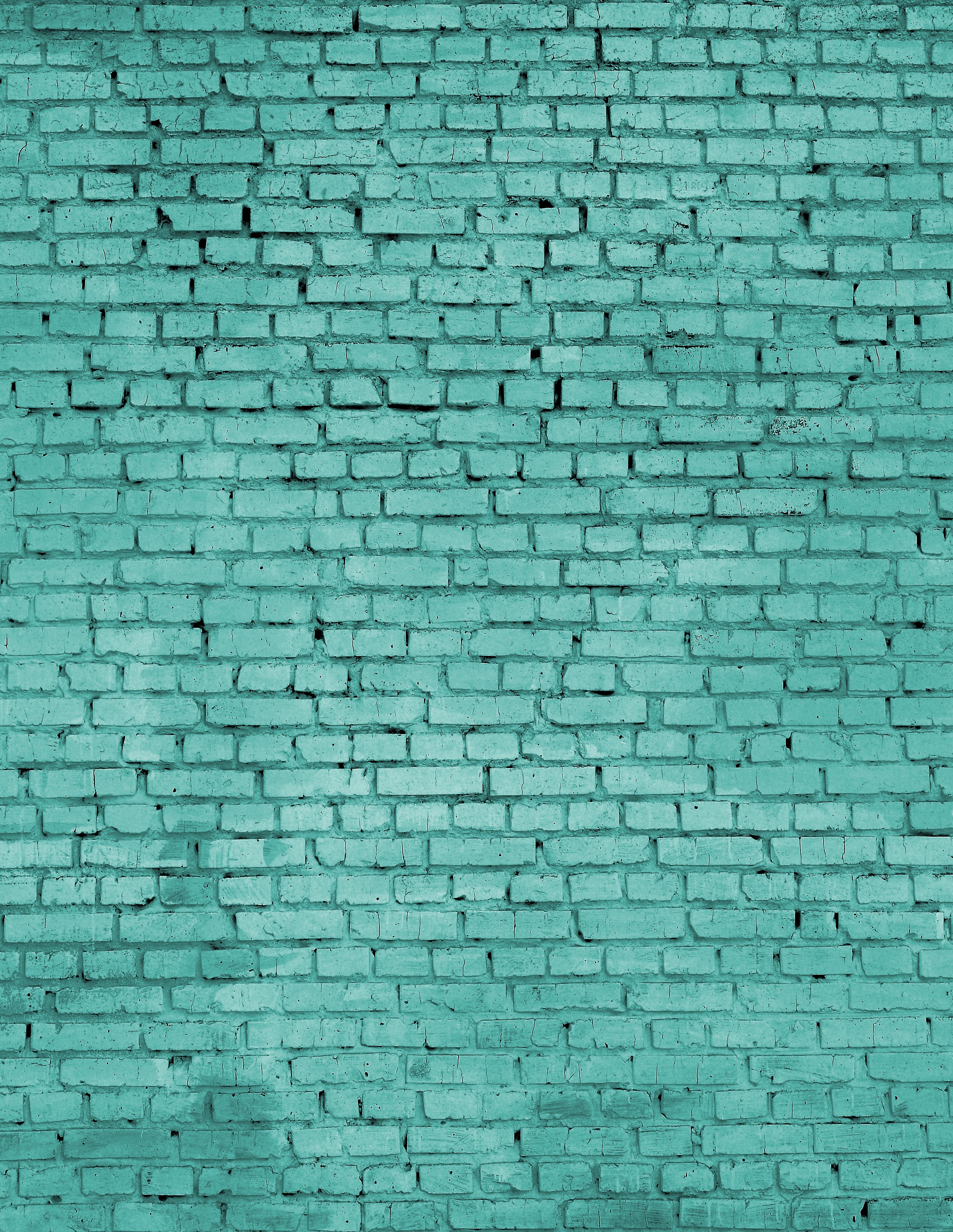
 EXECUTIVE DIRECTOR
Frank Lott
EXECUTIVE DIRECTOR
Frank Lott
 MANAGING EDITOR
MANAGING EDITOR
Becky Wood
DESIGN & PUBLICATIONS COORDINATOR
Yvette Campagna
MEDIA & COMMUNICATIONS COORDINATOR
Maegan Collins
MEMBERSHIP & MARKETING COMMITTEE CHAIRMAN
Larry Richardson
CONTRIBUTING WRITERS
Jeffrey V. Bibb

David Britton
Jimmy Trodglen
Anna Woten
CONTRIBUTING PHOTOGRAPHERS
Karla Tucker
John Juanito
The mission of this publication is to foster creativity and champion our area’s unique cultural diversity. SECOND & COMMERCE expands the Customs House Museum & Cultural Center’s purpose through supporting the arts community, exploring local history and telling stories about the past, present and future of Clarksville.
HISTORY, ARTS AND CULTURE INTERSECT AT THE CORNER OF SECOND & COMMERCE
Second & Commerce is both a place and an idea. The physical place has occupied the corner of Second and Commerce Streets for nearly 124 years. The idea is to provide you with a new publication that celebrates the history, arts and culture of our community.
The iconic structure located at the corner of Second and Commerce Streets was constructed in 1898 as a United States Post Office and Customs House. It stands today as both witness to and participant in the evolution of our community. Events of triumph and of tragedy have passed below the watchful gaze of the ever-present federal eagles perched above the building’s corners overlooking Downtown Clarksville. As the current occupant of this majestic jewel since 1984, the Customs House Museum & Cultural Center has chronicled, documented and shared the unfolding story of “becoming” Clarksville during its tenure here… and so our collective journey continues.
Lott EXECUTIVE DIRECTOR
The rationale for undertaking the new Second & Commerce journal is that our Museum should be more than a physical place for housing artifacts and presenting exhibits. The justification for the publication stems directly from the Museum’s own mission, which is to collect, preserve, interpret and present historical content, programs and exhibitions to our constituents. Sharing stories from the past, as well as current information about our diverse community, may not be novel or unique – yet this became the motivation for producing a new quarterly journal dedicated to the history, arts and culture of Clarksville and Montgomery County.
From the planning, printing and distribution of the very first issue of Second & Commerce, we are charting a new course for the Museum. We feel confident about this venture because we indeed have such a rich history, vibrant arts community and cultural energy that lifts us to a higher status among our peers. And we are pleased that other local arts organizations, cultural entities and interesting individuals will be featured in this publication, truly making it a community asset.
We are positive that you will embrace this new quarterly and hope that you look forward to each issue. So now…
Welcome to Second & Commerce.
SECOND & COMMERCE / 1
HOURS OF OPERATION Tuesdays–Saturdays 10 am–5 pm Sundays 1–5 pm Closed Mondays customshousemuseum.org @customshousemuseum #customshousemuseum
Frank


2 / SECOND & COMMERCE 1 / Director’s Letter 4 / Arts & Culture Calendar 8 / Member Spotlight 25 / Seasons: The Museum Store 26 / Happening at the Museum 28 / Connect with Us THE POWER TO GIVE. Decorated veteran. Dedicated reintegration advocate. Leading donor. A life well planned can offer each of us – any of us –The causes that inspire you are as unique as the life you lead. We all live and give differently, but the support of the right financial partner has the power to multiply generosity. It’s our privilege to help people make an impact – and to make our own. © 2020 Raymond James Financial Services, Inc., member FINRA/SIPC. Securities offered through Raymond James Financial Services, Inc., member FINRA/SIPC, and are not insured by any financial institution insurance, the FDIC/NCUA or any other government agency, are not deposits or obligations of the financial institution, are not guaranteed by the financial institution, and are subject to risks, including the possible loss of principal. The financial institution and the investment center are not registered broker/dealers and are independent of Raymond James Financial Services. Investment advisory services offered through Raymond James Financial Services Advisors, Inc. Raymond James is not affiliated with the organization mentioned. 20-BDMKT-4162 BS 3/20 F&M Investment Services is proud to support Customs House Museum and Cultural Center. Clark Nicholson, Amy Zimmerman, Frazier Allen Financial Advisors 50 Franklin Street Clarksville, TN 37040 T 931.553.2048 T 833.270.0640 www.raymondjames.com/fminvestmentservices TABLE OF CONTENTS ON THE COVER: Now & Then Customs House Museum & Cultural Center Maegan Collins, photographer, 2021 Post Office and Customs House construction Photographer unknown, 1898 Archives Collection, Customs House Museum and Cultural Center CONTACT Advertising Inquiries Arts & Culture Events Article Submissions Please email Becky Wood at becky@customshousemuseum.org customshousemuseum.org/ secondandcommerce The Clarksville Montgomery County Historical Museum (d.b.a. Customs House Museum & Cultural Center) is designated by the IRS as a 501 (c) (3) non-profit organization. © Customs House Museum & Cultural Center 2021-10/2021-4M
Features IN THIS ISSUE
5 / Moving Mountains
The beauty and grandeur of Roan Mountain inspired Appalachian Morning, 2021’s Flying High Signature Piece. Larry Richardson joins a curated list of local artists commissioned for the Museum’s largest fundraiser.

6 / From Parcels, to Power, to Enlightenment

Since 1898, the iconic structure on the corner of Second & Commerce Streets has housed a federal post office, department of electricity and general interest museum. The building itself may be the Customs House Museum’s greatest artifact.
9 / Connecting Campus & Community
College Street’s newest attraction embraces the creative arts. A large-scale mural by local artist Olasubomi Aka-Bashorun and APSU art major Karley Davis celebrates the diverse student body at Austin Peay.

10 / Road to Emancipation
Some important pieces have been missing from the local mainstream historical narrative regarding Clarksville during the Civil War. Dunbar Cave State Park Manager David Britton tells the fuller story of the Freedmen of Clarksville’s Civil War contraband camp and Affricanna Town community.

14 / A Lasting Legacy

There are words and phrases repeated by Dan Hanley’s family and friends that help define his life and works: Mentor. Gifted artist. Incessant researcher. Storyteller. Irish practicality. Extraordinarily kind. The art, influence and community impact of Hanley’s life is all around us.
20 / Clarksville’s Racing Scene
Decades after its first lap, auto racing continues to speed into next generation here in Clarksville. The history and community behind the Clarksville Speedway is the inspiration driving the exhibit Start Your Engines! A Celebration of Racing in Montgomery County.

SECOND & COMMERCE / 3
ARTS & CULTURE CALENDAR
OCTOBER
ARTSVILLE FEST
Downtown Clarksville
Thursday, Sept 30 – Saturday, Oct 2
FOLLOW THEIR FOOTSTEPS: TRAIL OF TEARS INTERPRETIVE HIKE
Port Royal State Historic Park Saturday, Oct 2 | 9:30am
FIRST THURSDAY ART WALK
Downtown Clarksville Thursday, Oct 7 | 5-8pm
HISTORIC GREENWOOD CEMETERY WALKING TOUR WITH ARTIFACT STORIES
Greenwood Cemetery Saturdays in Oct (2, 9, 16, 23, 30)
BURT-COBB HARVEST FESTIVAL
Burt-Cobb Recreation Center Friday, Oct 15 | 5-7pm
CHAFF HISPANIC HERITAGE MONTH FESTIVAL
Veterans Plaza Saturday, Oct 16 | 10am-4pm
CHOIR FEST
Austin Peay State University Wednesday, Oct 20 & Thursday, Oct 21
CLARKSVILLE COMMUNITY CONCERT ASSOCIATION PRESENTS: DO-HYUN KIM, PIANO
Austin Peay State University Mabry Concert Hall Sunday, Oct 24 | 3pm
HALLOWEEN AT FORT DEFIANCE
Ft. Defiance Civil War Park & Interpretative Center Friday, Oct 29 | 6-8pm
FRIGHT ON FRANKLIN
Downtown Clarksville Saturday, Oct 30 | 3-6pm
NOVEMBER
FIRST THURSDAY ART WALK
Downtown Clarksville Thursday, Nov 4 | 5-8pm
MAGIC OF THE MIND WITH JEFF AND KIMBERLY BORNSTEIN
Customs House Museum & Cultural Center
Friday, Nov 5 & Saturday, Nov 6
CECA VISITING ARTIST SPEAKER
SERIES: PAUL RUCKER
Austin Peay State University, Art + Design Building Tuesday, Nov 9 | 6pm
CLARKSVILLE COMMUNITY CONCERT ASSOCIATION PRESENTS: WINDSYNC, WOODWIND QUINTET
Austin Peay State University Mabry Concert Hall
Friday, Nov 12 | 7:30pm
HANDMADE HOLIDAYS
Wilma Rudolph Event Center Saturday, Nov 13 & Sunday, Nov 14 | 9am-4pm
APSU THEATRE AND DANCE: FALL DANCE CONCERT
Austin Peay State University, Trahern Building Thursday, Nov 18 – Sunday, Nov 21
CHRISTMAS ON THE CUMBERLAND GRAND OPENING CEREMONY
McGregor Park RiverWalk Tuesday, Nov 23 | 5pm
DECEMBER
FIRST THURSDAY ART WALK
Downtown Clarksville Thursday, Dec 2 | 5-8pm
NOEL NIGHT
Seasons: The Museum Store Thursday, Dec 2 | 5-8pm
VOYAGE OF ADVENTURE: RETRACING DONELSON’S JOURNEY FILM SCREENING
WITH
Customs House Museum & Cultural Center
Sunday, Dec 5
A 19TH CENTURY CHRISTMAS
Ft.
KWANZAA CELEBRATION
Kleeman Recreation Center
Saturday, Dec 18 | 11am-3pm
4 / SECOND & COMMERCE
JOHN GUIDER AND JEFF SELLERS
Defiance Civil War Park & Interpretative Center
Saturday, Dec 11 | 2pm
The Art of
OCT 27
A Celebration of Hispanic Heritage and Hope THROUGH NOV 7
Beyer: Still THROUGH NOV 28
Your Engines! A Celebration of Racing in Montgomery County THROUGH DEC 31
Paintings by Judy Lavoie
– JAN 2
Visual Songs, Many Verses NOV
– JAN 30
CURRENT & UPCOMING MUSEUM EXHIBITS Familiars:
Beverly Parker THROUGH
Esperanza:
Anne K.
Start
Interactions:
OCT 5
Jim Diehr:
3
– JAN 30
Small
– FEB
– JAN 1
John Guider: Journeys NOV 9
The Petite Voyage:
Works by Paul Harmon NOV 3
6 Customs House Christmas Village NOV 16
programs and more
Learn more about Museum exhibits,
at customshousemuseum.org customshousemuseum.org/events
BY BECKY WOOD, MANAGING EDITOR
“The openness, that’s what you experience; there’s nothing between you and the clouds.”
That was Larry Richardson’s first impression of Roan Mountain, the subject of his signature piece for Flying High 2021. Every year, a signature artist is chosen by the Customs House Museum & Cultural Center to create a unique piece of art for its largest annual fundraiser.
Richardson, known for his work depicting scenes along the Cumberland River, took this opportunity to bring a slice of East Tennessee wilderness here to Clarksville.
Roan Mountain is nestled in the Unaka Range of the Southern Appalachian Mountains along the Tennessee-North Carolina border. In the summer, the mountain is sprinkled with patches of pink and crimson rhododendron blooms, mimicking the roan horse coat color pattern. “Roan” is also a Scots-Irish word for “red.”
“But, the most unusual site in the highest points were the ‘balds,’ where only shrubs and grasses grow,” explained Richardson. “Botanists are still trying to figure out why this centuries-long phenomenon exists.”
As an avid writer, painter and naturalist, Richardson has been visiting Roan Mountain for over fifty years.

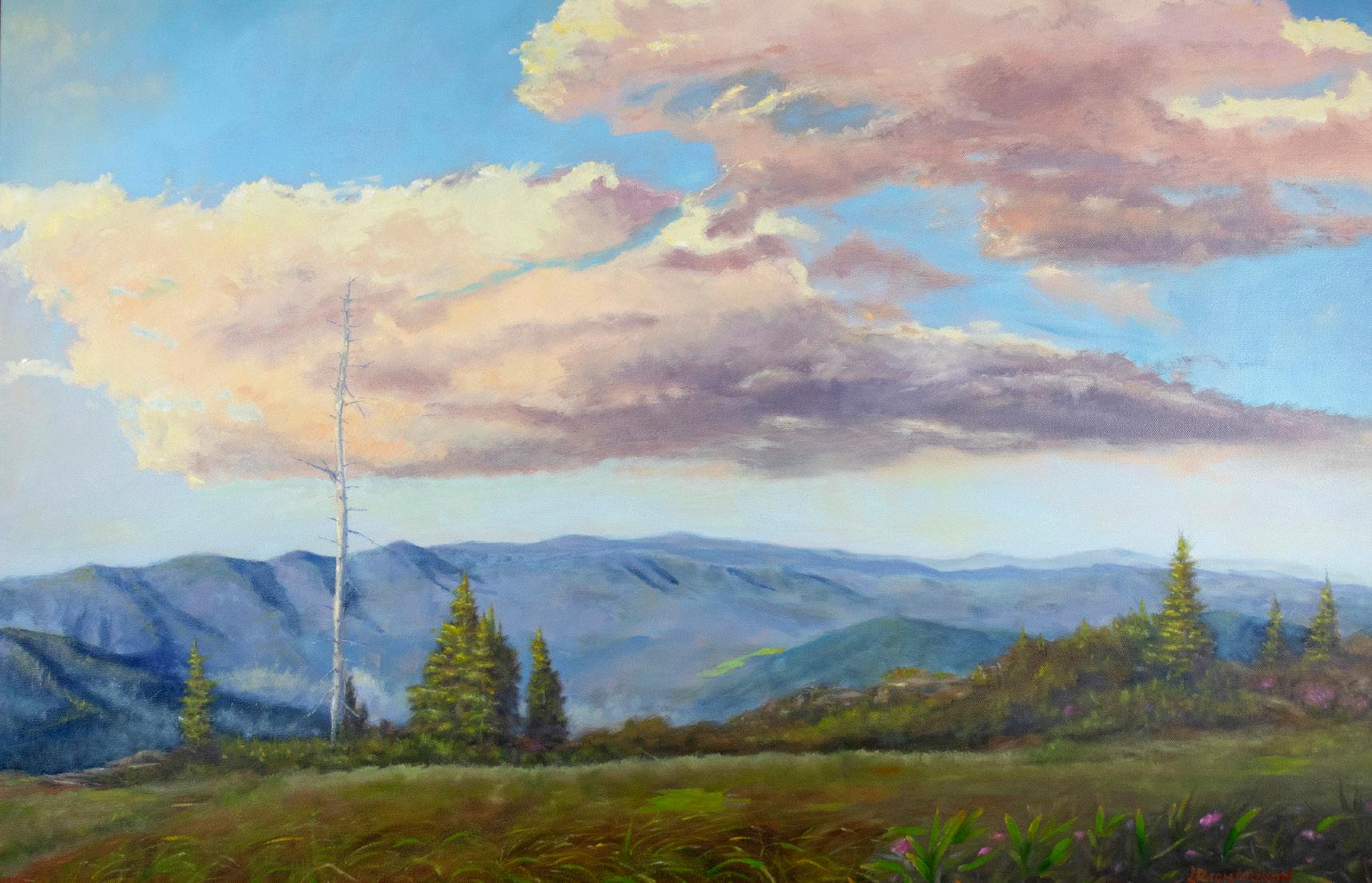
“I had just graduated with a master’s degree in biology and joined the Tennessee State Parks naturalist team. To become familiar with Tennessee’s natural beauty, a field trip to the eastern-most prominence took place in June where Roan Mountain’s famous rhododendron bloom was underway. The mountainsides were draped in reds and pinks. At 6,200 feet, we were literally in the clouds.”
At Flying High, Appalachian Morning capped off the evening’s live auction, which featured a variety of works by local artists. Richardson’s oil painting brought in $5,000 for the Museum with a winning bid by Todd Harvey of Byers & Harvey Real Estate.

“Painting is for my own enjoyment, and if others like what’s on the canvas, then it’s even more enjoyable for me,” said Richardson. “There is always a painting in progress on the easel with a subject captured by my camera or saved in my sketchbook.
“Appalachian Morning is a tribute to the awe-inspiring vista that arouses wanderlust in one to seek other adventures in the wilderness. And, I have.”
SECOND & COMMERCE / 5
MOUNTAINS Appalachian Morning Soars At Flying High “The mountainsides were draped in reds and pinks. At 6,200 feet, we were literally in the clouds.”
cumberlandriverartist.com MOVING
Larry Richardson (right) with winning bidder Todd Harvey
CLARKSVILLE’S MOST ICONIC
From Parcels…to Power…to Enlightenment
United States Post Office & Customs House

A movement began in the early 1890s to construct a post office and public building in Clarksville to accommodate the city’s booming tobacco trade. Throughout the summer of 1896, a team of architects in the Department of Treasury drafted a set of preliminary plans.



The architectural design of this building caused a stir. The Department of Treasury immediately rejected the preliminary plans. William Aiken, supervising architect of the Treasury, subsequently approved a second set of plans, and a ceremonial groundbreaking took place on September 1, 1897. When Aiken released the approved designs to the people of Clarksville, they abhorred the blend of Italianate, Romanesque, Flemish and Gothic styles. They called the building an “architectural absurdity and a public laughing stock.” Aiken designed new plans, but once again, the community rejected them. Finally, construction based on the original plans resumed, and the new Federal Post Office opened to the public in November 1898.


Clarksville Department of Electricity 1940–1983

By the early 1930s, the Clarksville Department of Electricity was making strides with technological advancements. Demand for electricity grew as more of the community gained access to low-cost electricity, and new innovations such as streetlights made their way to town. Commercial enterprises were attracted by the newly-formed Tennessee Valley Authority’s low energy rates.

In 1939, the Federal Government sold the post office building to the City of Clarksville for $50,000. The young Clarksville Department of Electricity found a new home and occupied the building until 1983. Further electrical enhancements included the installation of the city’s first fluorescent light fixtures. Now converted to energy-efficient LED light bulbs, these fixtures continue to illuminate the front lobby of the 1898 building. In 1972, the National Register of Historic Places added the building to its list of protected sites.

1898–1939
Top: Horse and buggy on Second Street Bottom: Group of postmen ready for deliveries in what is now the Museum Courtyard
Left: Laying of the Cornerstone, December 10, 1897 Right: Post Office and Customs House Construction, 1898
In 1940, the building became the new home of the Clarksville Department of Electricity
A parade marches past the building when it was home to the Clarksville Department of Electricity, 1961
Clarksville’s first fluorescent light fixtures in the Clarksville Department of Electricity lobby
Courtesy of Gary Norris
Courtesy of Gary Norris
Courtesy of Library of Congress
Courtesy of Library of Congress
STRUCTURE Enlightenment
BY MAEGAN COLLINS, MEDIA & COMMUNICATIONS COORDINATOR
Customs House Museum & Cultural Center
1984–Present
In 1983, the City of Clarksville leased the building to the newly formed ClarksvilleMontgomery County Historical Museum. With some remodeling, the Museum opened in June 1984 to coincide with the city’s bicentennial celebration. The Museum expanded in 1996, adding 35,000 square feet to display more historical, artistic, cultural and scientific artifacts from its collections.
Top: 1984 ribbon-cutting for the opening of the Clarksville-Montgomery County Historical Museum


Bottom: 1996 opening of the Museum expansion
On January 22, 1999, destruction found Clarksville in the form of an F3 tornado. Five blocks of the downtown area were seriously damaged; over 100 buildings were destroyed, and another 560 were damaged. Fortunately, the Museum survived, but incurred nearly two million dollars in damage and closed for ten months. Upon reopening, the scope of the Museum expanded and the name shifted to the Customs House Museum & Cultural Center.


Embellished with terracotta, slate, copper and marble, the Museum is one of the most photographed buildings in Tennessee. With the addition of full-spectrum LED lights lining the perimeter of the roofline, the illuminated structure can be viewed from many vantage points in Downtown Clarksville.


The magnificent edifice stands today as a beacon of enlightenment for the community.
The
The Museum’s Greatest Artifact
BY ANNA WOTEN, CURATOR OF COLLECTIONS & REGISTRAR

“The building is unusually flamboyant in style for its size. Its highly pitched roof with large eagles on the four corners, its steep gabled windows and elaborate terracotta ornamentation combine to give importance to a relatively small building.”
- National Register of Historic Places Inventory Nomination Form, June 1972
When museums decide to bring in objects for our collections, we do so with the understanding that we will preserve them for future generations. We have a number of tools and strategies at our disposal, but sometimes the objects are too large to sit safely within our carefully controlled Collections Storage. One such object is the Customs House itself!
Buildings bring their own set of challenges to preservation. Our collections are normally kept within environmentallycontrolled spaces, but the Customs House is constantly exposed to elements like weather and pollution. All of these factors slowly wear down and damage the historic structure, and it takes special care and attention to keep the building safe.
And although the building’s history is vital to Clarksville’s story, it is significant for another reason, too. The architecture of the Customs House is quite unique to the state of Tennessee. A mixture of Queen Anne and Stick styles, the Victorian structure is unlike anything else you will find in the state. It has been called “unusual” and “flamboyant” by historians in the past, but we are quite fond of it here at the Museum!
Damage from the F3 tornado that devastated Downtown Clarksville during the early morning hours of January 22, 1999
building becomes the talk of the town once again when illuminated for the first time in 122 years, October 3, 2020
MEMBER
SPOTLIGHT: JAMIE DURRETT
Jamie Durrett has been a Museum member for over ten years, served on the Museum Guild as President and Flying High Chair and became Chair of the Museum Board of Trustees in 2021.
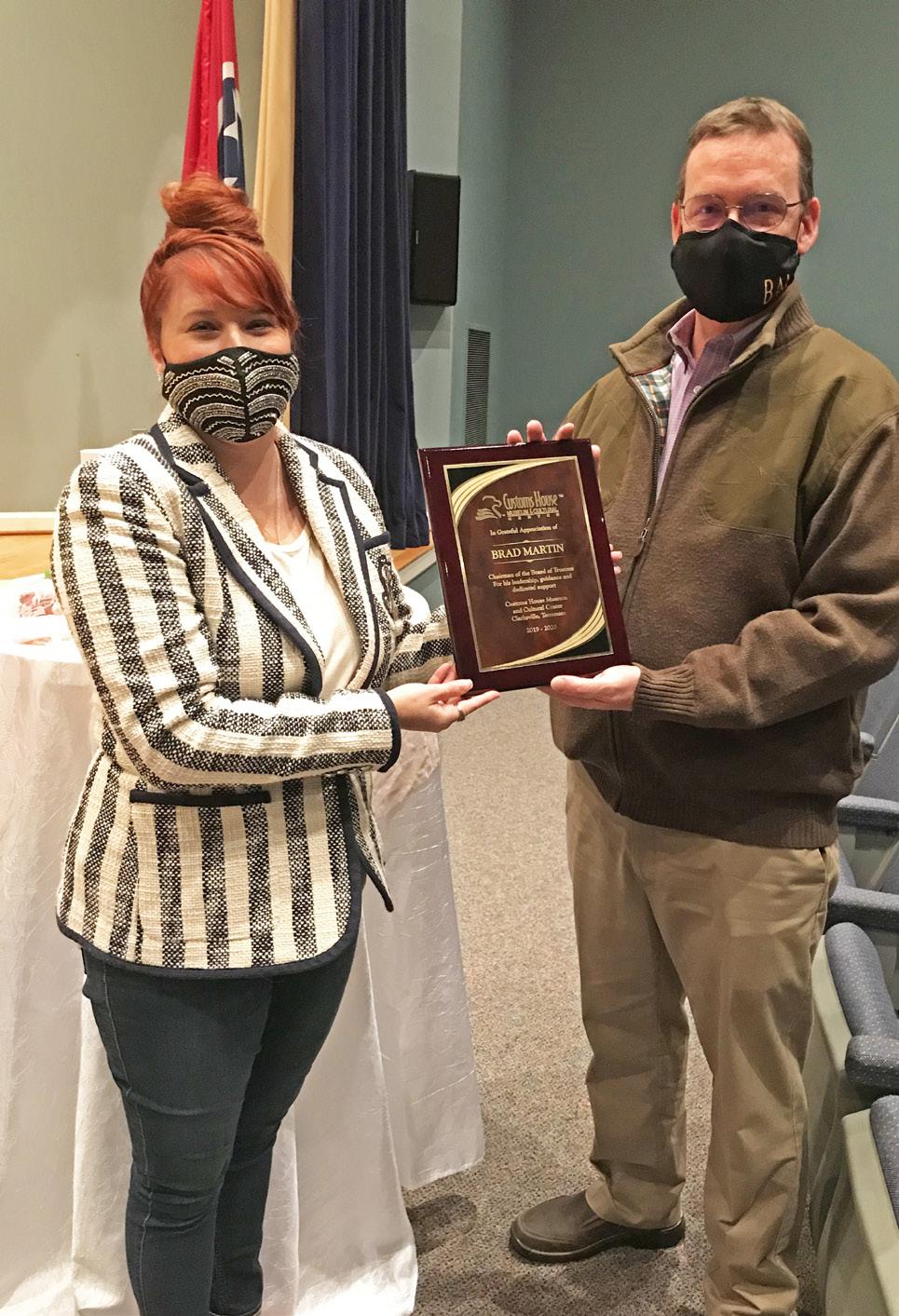


S&C: What has inspired you to be so involved in Clarksville’s arts community?
JD: I think it goes back to my family’s involvement in the arts. My grandmother was an art teacher, and my grandfather was also an artist... I grew up with the idea that art is important. As I got older, I wanted to find ways to give back. I’ve been around the Museum since I was young, and thought that working with them would be a good way to give patronage to the arts community.
S&C: How have you seen the arts and culture community in Clarksville evolve throughout your time here?
JD: I think it has become more important to Clarksville in general – not just the Museum, but having The Roxy, the new performing arts center, the Downtown Artists Co-op, the DBO Gallery and more all downtown too. I think there is a lot more support on a local government level than there used to be. People are starting to see Clarksville as an artist hub. People want to be involved, and they want that community connection now more than ever. As we move forward, I think people are going to seek out these connections while artists find new and creative ways to show their skills and how they view things. I think we will continue to see our arts and culture community grow.
S&C: What are your favorite Customs House Museum memories?
JD: I have wonderful memories of the Customs House from a young age when I attended Junior Cotillion and enjoyed the many youth activities at the museum. My favorite recent Museum memory is planning Flying High in 2015. I loved getting to work with all the great vendors and artists, as well as the Guild members and Board members. Getting to see it all come together and having a great time supporting the Museum and raising money – it was really special.
The Customs House Museum is more than an architecturally beautiful building with galleries. It is an opportunity to look at the community and world with new eyes and renewed passion for history and the arts. The Museum has been a wonderful place for me to grow, learn, develop and volunteer. It’s rare to find a museum in a town this size that has the depth and the breadth of the kinds of exhibits found here, and the positive reputation across the country.
Interested in becoming more involved with the Museum? Join the Guild! The Customs House Museum & Cultural Center Guild is a group of talented volunteers who promote awareness and support for the Museum by creatively developing, organizing and funding various special events throughout the year, including the signature Flying High and Champagne & Chocolate fundraisers. For more information on how to join, please contact Stacy Mobley at stacy@customshousemuseum.org.
“I want to bring even more awareness to Clarksville’s arts community, which I think is a welcoming one with a lot of room to house new talent...
I see that as a lifelong project of mine.”
Since the creation of its creative arts subcommittee, the Austin Peay State University Foundation was in search of a bold and interactive project to bring awareness to the creative arts at Austin Peay.
Ultimately, the answer was right in front of them – inspiration struck in the form of a long white wall stretched between the Barnes & Noble Ann Ross Bookstore and the Jenkins Building, which houses the Office of University Advancement. While Clarksville is home to several impressive murals, none had yet been produced for the university.
That void has been filled by a new eyecatching work of art. The final design is a collaboration between local artist Olasubomi Aka-Bashorun and APSU studio art major Karley Davis. AkaBashorun is the artist behind several well-known murals in town, and Davis is currently in her junior year at Austin Peay.
“We always wanted to incorporate our students, but we weren’t sure what that would look like,” explained Jerica Swiger, Director of Development for APSU’s Office of University Advancement. “So, we put out a call for artists. Karley submitted a body of work that really made us pay attention.”
For her winning submission, Davis was inspired by the variety of tattoo shops that can be found in Clarksville.
“I love tattoos,” said Davis. “I wanted to combine that element of Clarksville with Austin Peay in an American traditional style... It’s been such a rewarding experience.”
Her original submission has been incorporated into the mural’s much larger design, which features a diverse range of students along with Austin Peay’s Browning Building and GOV-1 helicopter. The wall integrates a variety of interactive elements, including a scavenger hunt for small Tennessee-related icons hidden among the larger figures.
“A goal of the mural is to bring the two sides of campus together – many people don’t recognize that this is still Austin Peay on the other side of College Street,” said Swiger. “We’re creating our own little destination here on campus.”


Funding and materials for the mural are courtesy of generous donations by the Jenkins Family, Orgain Building Supply, and Thompson’s Paint.
“We’re really thankful for the community embracing this project,” said Swiger. “We hope that this is just the beginning.”
draftsbyola.com @draftsbyolasubomi @fuzzypicklesart
BY BECKY WOOD, MANAGING EDITOR
New College Street Mural Celebrates the Diverse Student Body and Creative Arts at Austin Peay
CONNECTING CAMPUS & COMMUNITY
ROAD TO EMANCIPATION
The Freedmen Of Affricanna Town and Clarksville’s Civil War Contraband Camp
 BY DAVID BRITTON,
BY DAVID BRITTON,
The story of Clarksville and Montgomery County during the American Civil War usually recalls the events of February 1862, when gunboats ascended the Cumberland River from the recently fallen Fort Donelson, landing at the riverfront in Clarksville. We think of the Confederate Fort Sevier, captured by the United States Army and renamed Fort Bruce, later renamed again as Fort Defiance. If we are more attuned to local Civil War stories, perhaps we think of Riggins Hill and the U.S. Army-sponsored picnics at Dunbar Cave.
However, the journals of Nannie Haskins and Serepta Jordan, as edited by historians Minoa Uffelman, Eleanor Williams, Phyllis Smith and Ellen Kanervo, have shown us that the whole story is far from the white-male, militarydominated one with which we are familiar. Though they were Confederate sympathizers with a great deal of antipathy toward the U.S. Army, both journals remind us that war is never fought only on the battlefield.
Clarksville was a community wholly and totally engaged and affected by the war. Further, these historians have demonstrated that there is still a massive untold story that includes everyone alive in that moment. Here, this includes the stories of recently emancipated African Americans. Clarksville is a community that was partially built by the stolen labor of enslaved African Americans. Their story deserves to be told.
10 / SECOND & COMMERCE
PARK MANAGER AT DUNBAR CAVE STATE PARK AND PORT ROYAL STATE HISTORIC PARK
Group of “contrabands” in Cumberland Landing, Va James F. Gibson, photographer, 1862
Courtesy of Library of Congress Prints and Photographs Division
Soon after the U.S. Army captured Clarksville in February 1862, many enslaved African Americans made the precarious trek away from their places of enslavement and into the military lines at Clarksville. The Emancipation Proclamation was issued by President Lincoln in January 1863, but this did not apply to the enslaved people of Tennessee. This stopped few from coming to Clarksville.
By the end of 1863, the 16th United States Colored Troop Regiment was recruiting at Fort Bruce, affording African American men the opportunity to serve in the Army. For many, this was an act of deliberate autonomy in their newfound freedom. However, most of these men who came to Clarksville to enlist or seek protection also brought families. The hundreds of recently enslaved people amassed around Fort Bruce in New Providence and in Clarksville around the military garrisons of the 83rd Illinois Regiment, seeking protection.

In early April 1864, Col. A.A. Smith of the 83rd IL, Post Commander, and Lt. C.D. Provine of the 16th USCT established a formal “contraband camp.” This camp
provided the formerly enslaved with food, clothing and shelter, as most had left their places of enslavement with only the clothes on their backs. Over the course of 1864, nearly 2,000 men, women and children came to the camp seeking refuge. By September of that year, about 200 had died
established in Clarksville to regulate and maintain the camp, and to provide labor contracts between Freedmen and former enslavers.
The camp at Clarksville consisted of several rudimentary barrackslike structures for housing, divided into 14x14 rooms with brick chimneys and bake ovens. Some camped in tents, others lived in abandoned buildings in Clarksville. Other structures in camp were offices, mess halls and schools. Capt. William Brunt of the 16th USCT was placed in charge of the camp in May 1864. By July, he secured permission to use the buildings of Stewart College as lodging for teachers and officers, and as a shoe-making school for the Freedmen. This camp was situated on 350 acres, most of which was dedicated to crops like corn and tobacco. The epicenter is now College Street, near where the former Vulcan Corporation Plant stood.
of disease, most of whom were children. In March 1865, the U.S. government established the Bureau of Freedmen, Refugees and Abandoned Lands to provide necessities and medical services for the recently emancipated, or “Freedmen.” A Bureau office was
While this camp was one of the most populated statewide, it was not the only such effort at community-making in Montgomery County. Enslaved populations had created their own communities among and between places of
Freedmen’s Village, Alexandria, Va. | Photographer unknown, ca. 1865 Courtesy of Library of Congress Prints and Photographs Division
The Emancipation Proclamation was issued by President Lincoln in January 1863, but this did not apply to the enslaved people of Tennessee.
enslavement, as autonomy and identity pervade and persist even through barriers of slavery. Some of these places likely remained communities after emancipation. In some cases, new communities were forged, or old communities given
One village that manifested in 1864 was Affricanna Town, a community established at Dunbar Cave. “Affricanna Town” was enslaver John N. Barker’s name for the community. Barker owned Dunbar Cave, and the village was

the authority to temporarily seize property for use by Freedmen.
By late 1864, a population of Freedmen of unknown size settled and created a community at Dunbar Cave. They were likely drawn together by existing relationships between the Barker and Warfield plantations, and the one thing that has drawn people to the cave for thousands of years –fresh water.
In 1865, a missionary named Lyman Abbott noted that some distance away from the military camp near Clarksville was a village “… where freed persons were allowed to erect their own house if they could procure their own lumber.”
place names, such as Cabin Row and Round Pond in the southern part of Montgomery County. It is possible that there were dozens of intentional and makeshift villages of Freedmen across the county, and hundreds throughout the South.
at least partly established on his land. He made several mentions of the activities of Freedmen at Dunbar Cave and nearby. Barker had little recourse, as he was a known Confederate sympathizer and the Freedmen’s Bureau had
In the 1930s, the Works Progress Administration interviewed many formerly enslaved people to recount their experiences. Among these interviewees was Samuel Bell of Indiana. Bell told the interviewer that he was enslaved
12 / SECOND & COMMERCE
Enslaved populations had created their own communities among and between places of enslavement, as autonomy and identity pervade and persist even through barriers of slavery.
Freedmen’s Village, Hampton, Va. Artist unknown, 1865 Courtesy of Library of Congress Prints and Photographs Division
in Montgomery County and had gone to the contraband camp as a young man. Growing tired of camp life, he requested permission to go live and farm in Dunbar’s Hollow, the valley created by the stream that emanates from Dunbar Cave. Bell also recounted his exploration of Dunbar Cave while he lived there.
By 1867, Affricanna Town had dissipated. It served a temporary purpose – to manifest autonomy and newfound freedom. However, it is likely that many of the residents stayed in the area. The 1870 Federal Census shows several African American families living along what is now Idaho Springs Road and Dunbar Cave Road – the former Barker and Warfield plantations. Over time, the village, like many others, was largely forgotten, aided in its disappearance by the mainstream local historical narrative. Dunbar Cave and the surrounding area
was developed into a resort by 1879.
Today, Dunbar Cave State Park recognizes the presence of an African American space and the accompanying story with
be installed roadside at the park, commemorating this place that represented freedom, personhood, and the pursuit of life, liberty and happiness for many African American families.
DUNBAR CAVE PROGRAMS AND EVENTS: tnstateparks.com/parks/ dunbar-cave
PORT ROYAL PROGRAMS AND EVENTS: tnstateparks.com/parks/ port-royal
three new wayside interpretive panels that provide the visitor with introspection into the era. Park programs are offered on the story of the village. This winter, a new state historical marker will
CURRENT PROJECTS OF THE TENNESSEE AFRICAN AMERICAN HISTORICAL GROUP: tnafricanamericanhistorical group.com
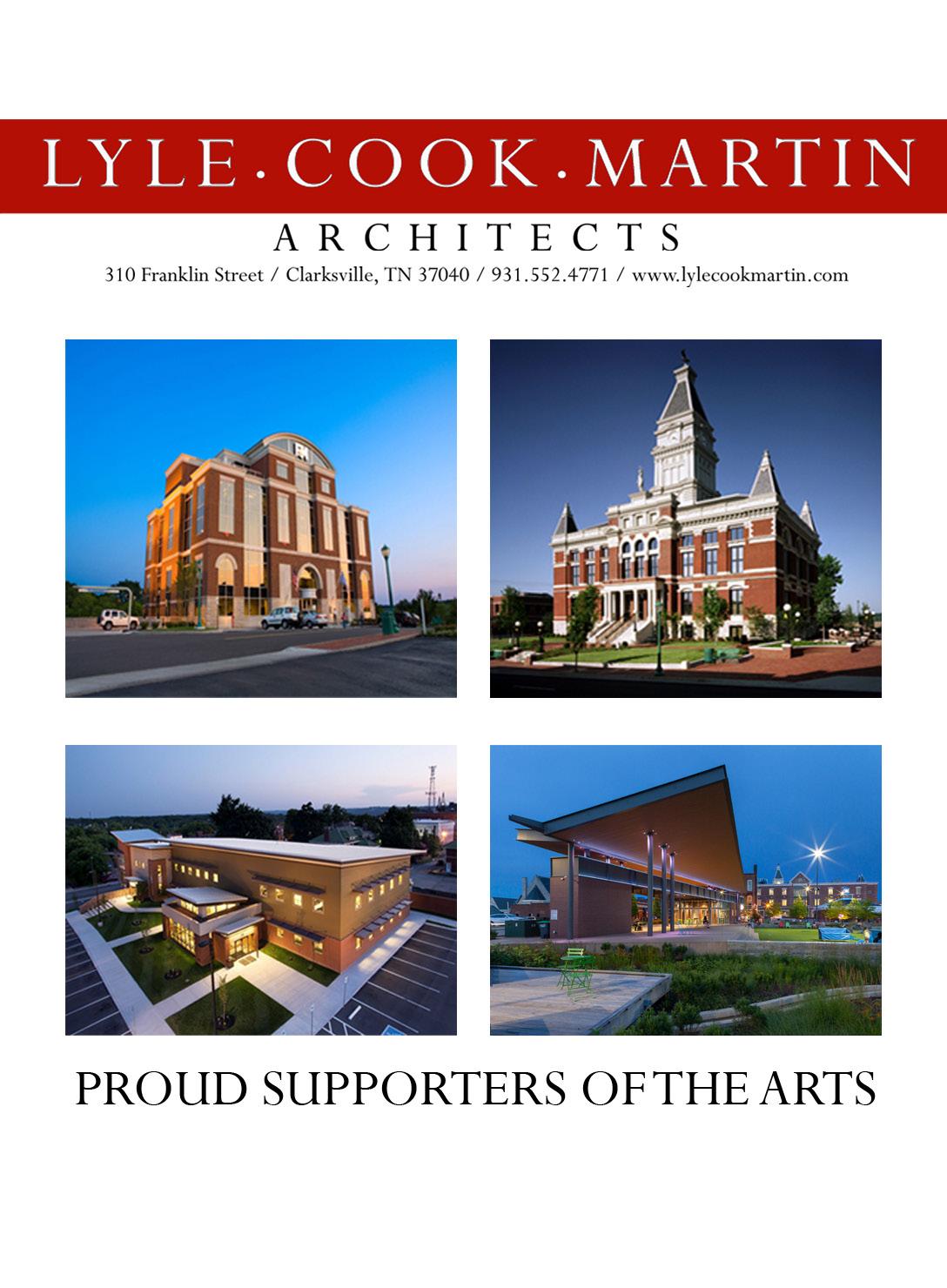
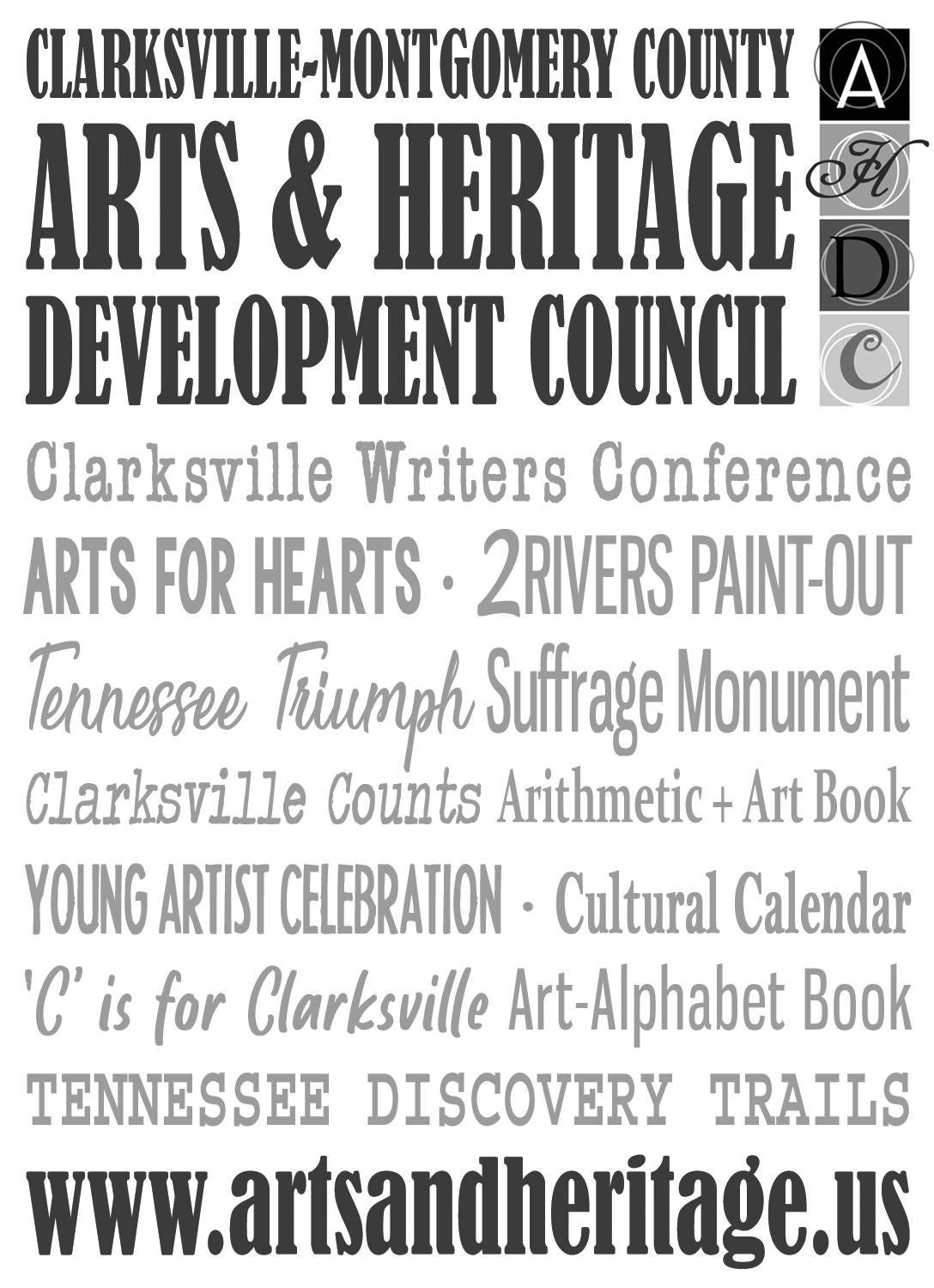
SECOND & COMMERCE / 13
It served a temporary purpose—to manifest autonomy and newfound freedom.
A LASTING LEGACY
The Life and Art of Dan Hanley
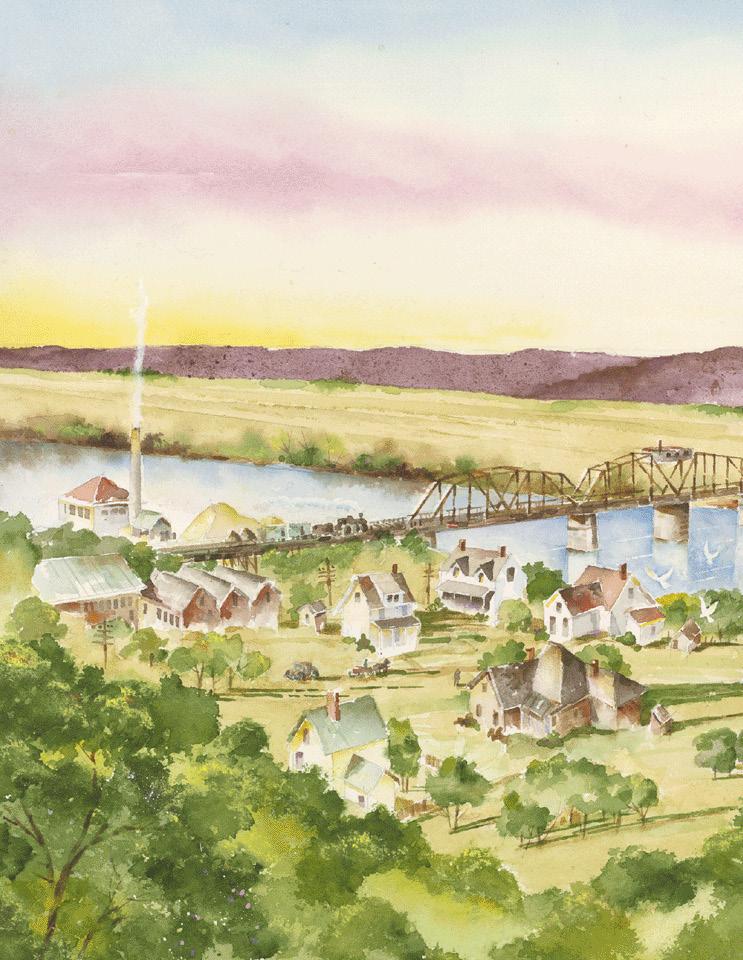 BY JEFFREY V. BIBB
BY JEFFREY V. BIBB
One of Dan Hanley’s closest friends and business collaborators, Lawson Mabry, is a multi-generational Clarksvillian, real estate developer, civic leader and community bank founder. When asked to comment on Dan’s contributions to others’ well-being, Lawson summed it up like this: “With Dan’s input, you never saw his footprints... only his subtle fingerprints.”
Dan Hanley perceived positivity in most everything he touched, and continually shared his immense talents, intellect, passion and perceptiveness in ways that will influence generations yet to come. His contributions to his home city were many, and emanated from his head, heart and hands.
I see us as a big ol’ jigsaw puzzle. We have all these pieces that are moving together in a way I think will culminate as a city we have yet to envision. You look around today... and it’s HAPPENING!
–Dan Hanley (1941-2021), a few weeks before his passing
 “Morning Watch” Dan Hanley, 2006 Flying High Signature Watercolor
“Morning Watch” Dan Hanley, 2006 Flying High Signature Watercolor
BEST KNOWN PUBLICLY FOR his watercolor paintings of local landmarks, Dan’s easy-going nature and inherent curiosity were greatly influenced by his upbringing as a Cumberland River kid. He was enveloped by multiple generations of close-knit family love and influenced by impressionable experiences along Front Street, now Riverside Drive. Dan was constantly attracted by the lure of the nearby Cumberland River.
Family kinship, sense of place and Cumberland River water ran deep within the veins of Dan Hanley. Dan and his younger brother Patrick were among the fourth generation of Hanleys in Clarksville. The family’s roots extend to the ancient Irish O’Hanley clan.
Ireland’s Great Famine in the mid19th century killed over 1 million citizens and stirred 1.5 million to immigrate to America for survival and a promising future. John Conroy, a stone crafter, fled Ireland in 1848 and settled in Clarksville. Shortly after the Civil War, Conroy sponsored Daniel Hanley’s immigration from County Cork, Ireland to America.
Daniel and Sara Beth Bridget McCarty settled near the Cumberland River. A stone tradesman as well, Daniel and Conroy were instrumental
in constructing a great number of projects – most notably Trinity Episcopal Church (1877) and Immaculate Conception Catholic Church (1890), both added to the National Register of Historic Places in 1982.
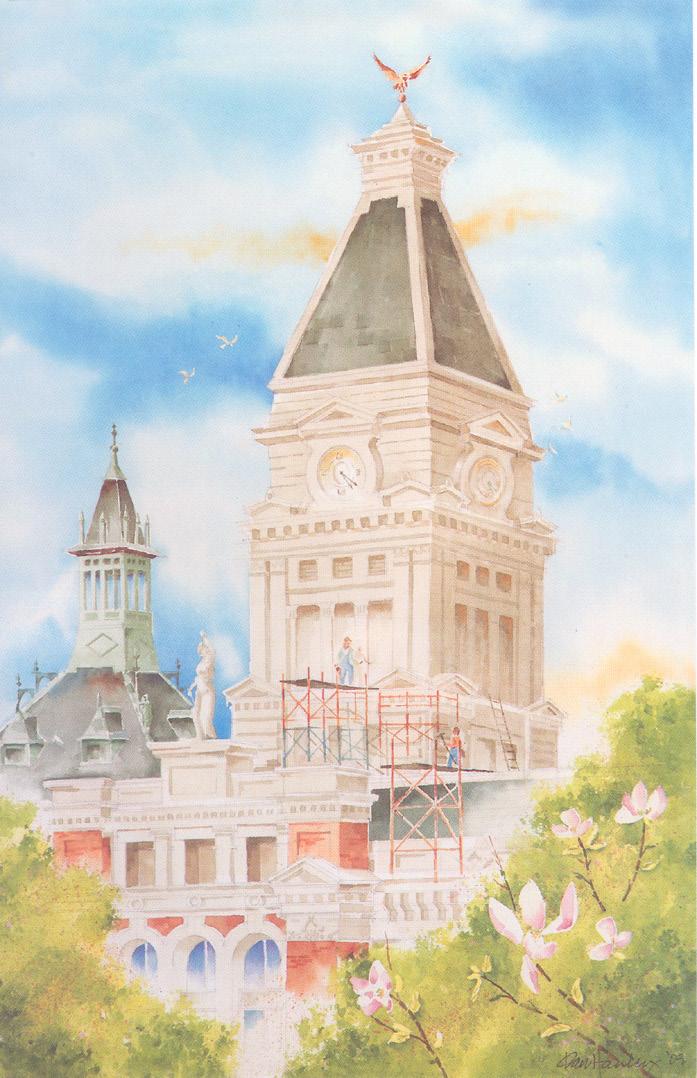
Dan Hanley often pondered: “I can look at Trinity Church – touch those stones – and wonder if my great grandfather put that stone in place or carved that decorative piece of stonework.”
Dan’s grandfather, William Adolphus “Babe” Hanley, died in 1941, the same year Dan was born. Married to Mary Alice Ellarson Hanley, Babe ran the steam engines that operated within the Clarksville Water Company pumping station just across Front Street, now known as the Old Waterworks Building. Dan absorbed stories about the ingenuity and resourcefulness of Babe Hanley from his grandmother and his father, J.D. Hanley.
In August 1941, newborn Johnny Dan Hanley was brought home to a new house at 26 Barker Street constructed by his dad. A comfortable and happy childhood was provided by his father and mother, Russell Aline Mobley Hanley, whom her boys remember as a fine writer, poet and instigator of various artistic endeavors. The Hanley and Mobley families were significant
influences – and extra sets of eyes –on Dan and Pat.
“DAN WAS THE BENEFICIARY of most of our dad’s talented traits,” observed Pat. “It was obvious he had rare abilities, even as a young boy. Neighborhood kids played as medieval knights making and painting our own shields. Dan’s was always by far the fanciest!”
During the boys’ youth, the Hanley family was consistently connected to the river, often taking out several boats, enjoying a cookout and playing music until the sun set over the rippling waters. In high school, Dan had his own boat and would occasionally “lock through” dams to Nashville’s Old Hickory Lake for several days of water skiing, fishing and camping out – which Dan said, “drove my parents to distraction.”
Dan graduated from Clarksville High School in 1959. He was focused on accomplishment, attending Tennessee Tech for a year before returning to Clarksville and Austin Peay State College to complete his bachelor’s degree in education. With a growing interest in art and design, professor Dr. Charles Young had a significant influence on Dan’s preferred painting medium of watercolor and his eventual entry into teaching with Montgomery County Public Schools.

16 / SECOND & COMMERCE
Dan (second from right) with students from Clarksville High School’s Crayola Kids Art Club, 1970 Courtesy of David Redmond
“Finishing Touches” Dan Hanley, 2003
Flying High Signature Watercolor
DAN WAS AN ART TEACHER at the “new" Clarksville High School on Richview Road, which opened in fall 1968. Not only was Dan popular with students, he was also deeply involved in numerous student activities, such as designing and constructing props for elaborate theatrical productions and guiding homecoming float construction. His passion for artistic expression inspired countless students, many of whom kept ties with their teacher, and are still pursuing artistic endeavors.
David Redmond explained how, as a CHS sophomore, he was “kicked out of my trigonometry class for misbehaving... and sent to art class.”
David was introduced to watercolor painting by Dan.
“I fell in love with it immediately, and I recall how diligently Dan taught and mentored me in this unforgiving medium,” said David. “I was among many examples of students he took extra time to cultivate if they showed promise.”
Dan Hanley went above and beyond classroom experiences, such as organizing field trips for the CHS Crayola Kids Art Club, venturing to local landmarks for field sketching and painting, arranging for his students’ art to be displayed inside Nashville’s renowned Parthenon and teaming
with biology teacher Mike Filson for a trip to Florida to identify various marine flora and fauna species.
Now a retired dentist living near Memphis, David has maintained his passion for watercolor painting, having contributed several outstanding works to the annual Customs House Museum Flying High art auction.

painting in what he called the most ‘unforgiving’ medium,” said Customs House Museum Executive Director Frank Lott. “Even after sharing a few do’s and don’ts, the conversations always turned to subject matter and new compositions, primarily because Dan loved talking about possible subjects and ideas for paintings, not just technique. That’s evident, because his paintings always told a story.”
QUANTIFYING DAN HANLEY’S reverence for and influence on the City of Clarksville is like estimating the daily gallons of water flowing down the Cumberland River. It simply can’t be measured.
“Dan and I maintained a healthy, encouraging competition of sharing each other’s artwork, which brought the best out of us both. We always had great anticipation for the next round of artwork exchanges!”
In his later years, Dan turned his full attention to painting. His work is represented in many private and corporate collections in Clarksville and beyond. He also contributed numerous works to the Flying High art auction, including four years as the signature artist.

“As fellow watercolorists, Dan and I enjoyed many conversations about
In January 1999, an F3 tornado cut a swath through town that demolished irreplaceable historic landmarks and uprooted business and families, laying waste from Dan’s old neighborhood to five miles northeast in St. Bethlehem. Over 560 structures were damaged or destroyed.
At the time, Dan was the awardwinning Executive VP of Fox Ridge Homes, designing, building and marketing homes in the Brentwood area. Dan Hanley responded. He asked his company for a leave of absence because his city needed him – and he could not stand being on the sideline.
SECOND & COMMERCE / 17
Dan Hanley (1941-2021)
“Running the Line” Dan Hanley, 2008
His city needed him – and he could not stand being on the sideline.
At that time, Clarksville’s potential build-back was vulnerable to demolitions and structure designs that could significantly detract from the Downtown District’s historic character. A Downtown Redevelopment Task Force was established by newly installed Mayor Johnny Piper, with over 100 citizen leaders parceled over eight committees.
Dan assumed three key roles: Task Force Oversight Voting Member, Chair of the Planning & Design Committee and Co-Chair (along with banker Carolyn Pierce) of the Planning & Design Review Board.
The work of Dan and his capable committees successfully recommended guidelines and standards for future consideration. Notably, Dan sought out owners of damaged buildings to personally provide guidance, vision, restoration and construction advice – and even provided on-the-spot building concept sketches to help owners take immediate steps forward. All the while, he was thinking about how this tragedy could make his beloved hometown rise to greater heights, economically and aesthetically. Much
of the groundwork laid by Dan and others in these dark days have been essential to the recovery and ongoing revitalization of Clarksville’s city core.
“Dan was never concerned with getting credit for what he did. His satisfaction came from making people, projects, institutions and our community better,” said Lawson Mabry.
Among Clarksville’s most active residential developers, Lawson sought Dan’s expertise in creating “a unique sense of place” for individual neighborhoods, while providing good reason for developers to invest in more appealing resident amenities.
“Dan significantly influenced the creation of a local Cluster Ordinance for new neighborhood development to the benefit of residents, developers and local governments,” explained Lawson. “With Dan’s Fox Ridge Homes background – combined with his aesthetic and artistic gifts – our residents can enjoy parks, playgrounds, pavilions, walkways, landscaping, lakes and underground utilities, while reducing maintenance and infrastructure costs.”

Lawson continued, “He was all about fun details, too. For one of our neighborhood pavilions, Dan designed a weathervane with a dog howling at the moon. It’s a whimsical, artsy touch that gave us both great satisfaction.”
DAN AND BILLIE JO “JODIE” COX first noticed each other around 1973 while she was working at a Merle Norman Cosmetics store on Franklin Street. That first encounter soon flourished, and the couple was married on Nov. 15, 1974, at the Baptist Church in Jodie’s hometown of Elkton, Kentucky.
The call of the old Front Street neighborhood lured Dan and Jodie to build two charming boutique stores at the corner of Riverside Drive and Hickory Grove Blvd. in 1978. Hanley House was a gifts and home accents shop, that benefitted greatly from Jodie’s flair for interior design. Next door, The Wicker Place furnishings store nicely complemented Hanley House’s offerings.
Daughter Kerri Dannielle was born in March 1979, and there were still Hanley and Mobley family members in the immediate vicinity to help with child rearing and water-oriented activities.
18 / SECOND & COMMERCE
“Under One Sky” by Dan Hanley, 2007 | Special Commission by F&M Bank | Courtesy of the Clarksville Community Network
“The most important times for Dan were always family times,” said Jodie. “We truly cherished our at-home time with Kerri... even if sometimes home was in the shop! Dan and I always worked closely and very well together. We valued each other’s opinions.”
After Kerri married Michael Lusso, the couple eventually moved to Nolensville, Tennessee. Seeking to spend more quality time together led the Hanleys and Lussos to begin an annual family tradition by vacationing at Carillon Beach on Florida’s Panhandle. In 2010, Aubrie Grace Lusso was born, which provided Dan one more girl on which to dote.
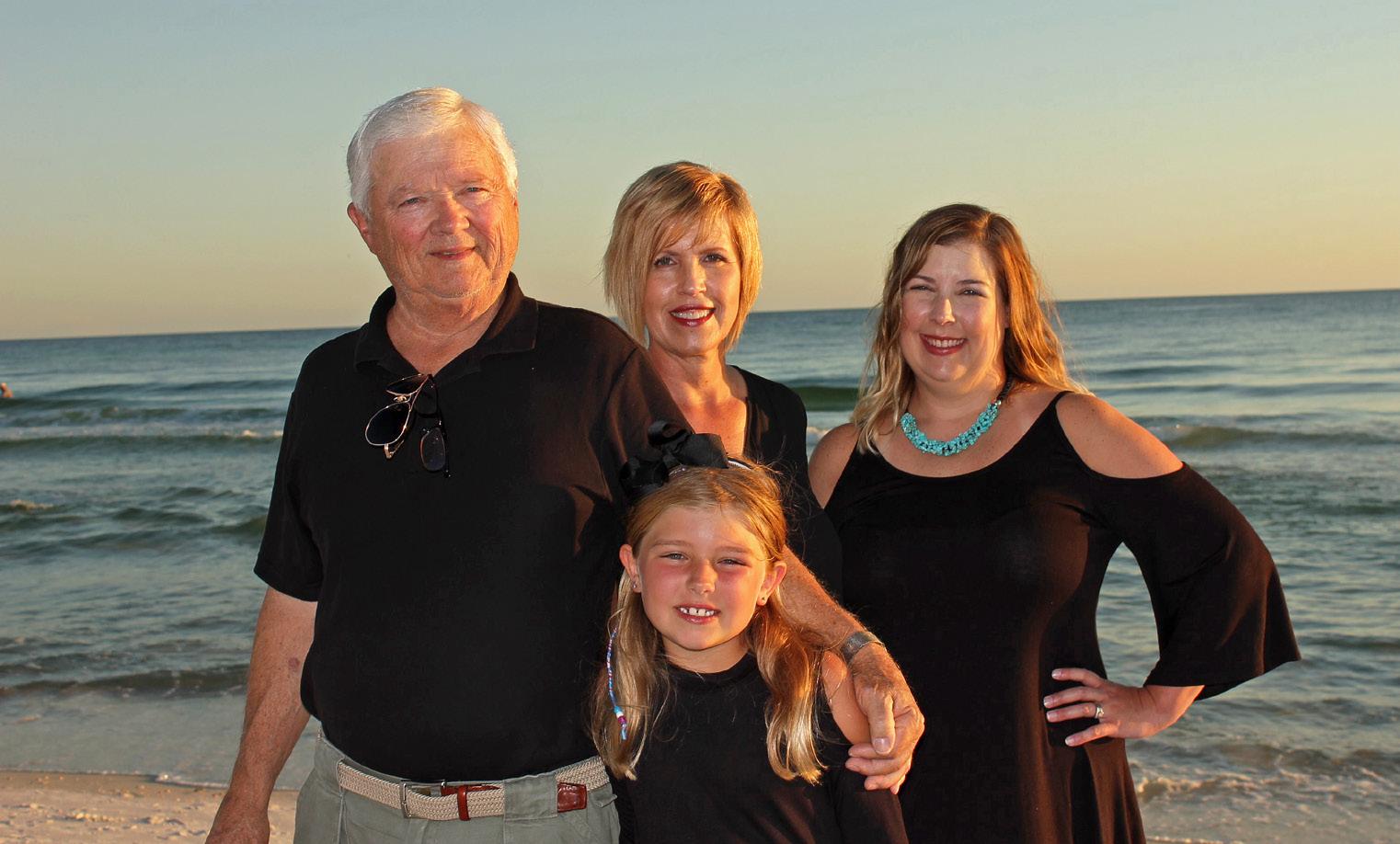
“Dan and I kept Aubrie one day each week from birth to her starting school,” recalls Jodie. “From the very beginning, Dan and Aubrie shared a magical connection.”

Aubrie’s name for her grandfather became “DanDaddy,” and the grandfather-granddaughter relationship between them was extraordinary. The two had daily phone conversations, and Dan taught her the finer points of fishing, painting and golf. He conceded Aubrie’s golf ability didn’t really need his help... she is outstanding with all three of these gifts.
Like a summer storm brewing over the Cumberland, Dan’s unexpected passing on May 17, 2021 sent waves of sadness through the minds and hearts of his and Jodie’s legion of friends. But true to Dan’s beaming personality, remembrances of Dan Hanley quickly turned into a celebration of his remarkable life, and the untold number of fingerprints that will forever remind us that Dan Hanley made a difference in our lives.
Remembering Artist Dan Hanley, a documentary about Dan’s upbringing and artistry, is now playing on CDE Lightband’s Clarksville Community Network.

SECOND & COMMERCE / 19
CONROY, MARABLE & HOLLEMAN
Dan with wife Jodie, daughter Kerri and granddaughter Aubrie in Carillon Beach, Florida Courtesy of the Hanley Family
CLARKSVILLE’S RACING SCENE THEN, NOW & NEXT
BY JIMMY TRODGLEN
From the dragstrip to the dirt track, Clarksville has a storied history with auto racing. Clarksville Speedway has produced local legends like Tony Albright and national champs like Jeff Purvis, and a passion for the sport continues to be passed down through generations.



Only a handful of institutions have existed for an interval equal to dragstrip and dirt track racing in Clarksville.
Dating back to the 1940s when dirt track racing was held at Clarksville Fairgrounds – now the current location of Austin Peay’s Hand Park, the baseball home of the Govs – the sport has captivated car enthusiasts who wanted to test their driving prowess, utilizing more horsepower on a clay surface with tight turns or on a straight paved track to test speeds and time.
A horse racing track once existed on the flat land between Dunbar Cave and Idaho Springs, and there is speculation that early unsanctioned auto races occurred there; but the verifiable history of racing on a dragstrip and a dirt track dates to nearly the time when Fort Campbell was established, and long before Austin Peay started playing sports at the Division I level. It has sustained itself at three locations, with its popularity continuing to accelerate.
THE EARLY RACING INNOVATORS
When dirt track racing left the former Clarksville Fairgrounds location, Pete Carpenter recognized a need to find a location for a dedicated dirt track. Carpenter, partnering with Wayne and Laurence Darnell, developed a track on a piece of property on Dover Road near Averitt Lumber Company.
The track started to form in the early part of 1952, with the green flag dropping that June. The track was named Buena Ventura, and drivers from across Kentucky and Tennessee frequently made up the starting lineup. Barry Carpenter, the son of Pete Carpenter, said crowds of more than 2,500 people watched the racing action.

20 / SECOND & COMMERCE
A young Jeff Purvis and his No. 15 stock car
Eddie Pace takes the checkered flag in his No. 31 car
Clarksville Dragway, 1964
The racing at Buena Ventura met an unexpected end toward the end of the 1950s when they discovered the track was situated in a protected environmental area where the property could not be used for commercial purposes. The last year of dirt track racing at Buena Ventura was the summer of 1960.
FROM BUENA VENTURA TO NEEDMORE ROAD
Needing a new location for a track, Pete Carpenter and Doug Greenfield were the catalyst for building a dragstrip and purchasing property large enough for an eventual dirt track. The Clarksville Dragway and Recreation Park opened in 1960, but driving on a dirt track would not return to Clarksville until 1963.
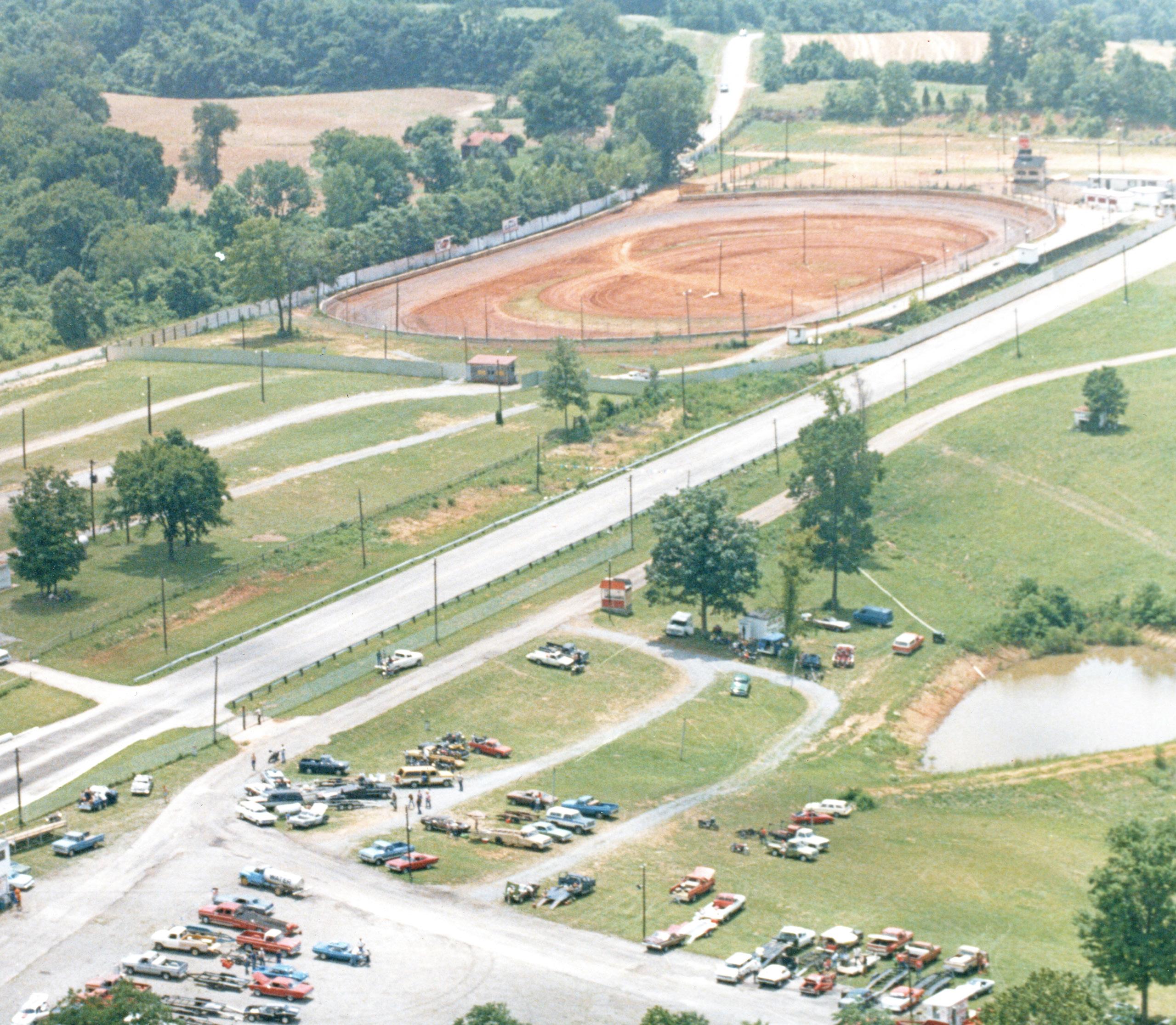
Before the dragstrip, Carpenter said racing on Clarksville streets was a common sight, including a popular stretch on Trenton Road where Northeast High School is now located. The Clarksville Speedway dragstrip allowed the action to move from the city streets to a designated and more secluded location.
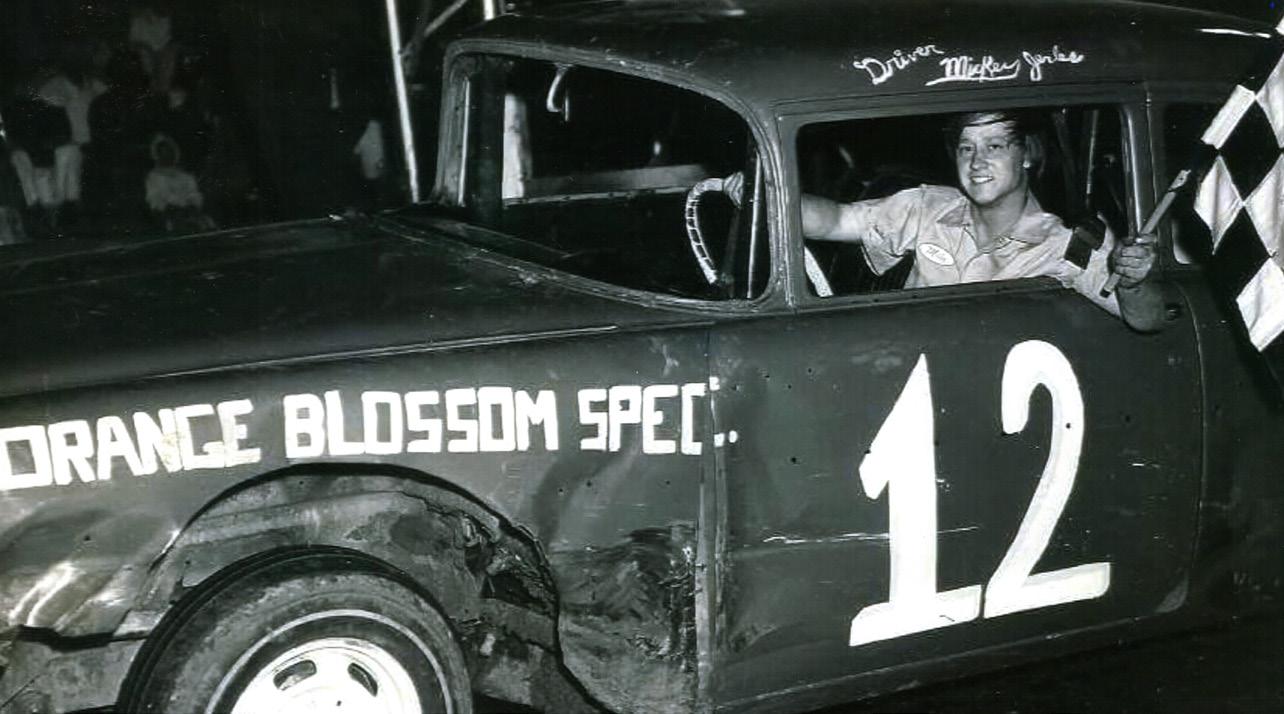
Greenfield oversaw the operations of the dragstrip, with John Ardinger setting the stage for the return of dirt track racing. Racing on dirt made a long-awaited return when Ardinger, who was president of Clarksville Speedway, Inc., announced surveys were underway for the purpose of building a clay oval track.

SAVING THE TRACK’S FUTURE
Along with their family business, Greenfield Trucking, the Greenfields went into track ownership, first operating the
Clarksville Speedway Dragstrip, before taking over the ownership of Union Hills Track, now Music City Raceway. The Greenfields owned the dragstrip for 22 years, but never had an interest in the speedway’s oval clay track. Ownership of the dirt track exchanged hands multiple times in the 1970s before Tommy Jerles took over.


Jerles owned a construction company, so his daily itinerary became crowded with the operations of two businesses. His wife and two daughters became instrumental in the racing action on Saturdays. In the 20 years the Jerles family owned Clarksville Speedway, his daughters had the significant responsibility of handling the payouts to the drivers –and there was never an incident of a payout discrepancy.
Jerles was also the public address announcer for the Saturday night races and said it took 15 to 20 people, counting his wife and daughters, to run the show. He stepped away from track ownership in the early 2000s, but his appreciation for the track’s history has never wavered.
lost the racetrack there, it was always in my opinion we wouldn’t be able to get another one in Montgomery County,” Jerles said. “The racetrack was there, and if you go buy a house that’s close to the track you should expect some inconveniences if noise bothers you.”
SCOGIN TAKES OVER
Jerles knew when it was time for someone else to take over the track’s reins, and William Scogin became
“If we
“If we lost the racetrack there, it was always in my opinion we wouldn’t be able to get another one in Montgomery County.”
The first stock car in Clarksville, TN owned by Brad Martin and driven by K.T. Grizzard Jr., 1950
Motorcyclists at the Clarksville Dragstrip
Tony Albright in Victory Lane
Mickey Jerles and his No. 12 car, “The Orange Blossom Special”
the track’s owner in September of 2002. John McConnell was a partner in the track’s ownership from 2006-2008. Scogin leased Clarksville Speedway in 2001 and purchased the track a year later. He remembers wondering early if he had made a mistake.
“My very first night, I thought I was an idiot. I ran way too many heat race laps, and it rained out the last heat race,” Scogin said. “I figured I lost $10,000 and I had to pick up trash in the rain.”
Clarksville Speedway isn’t home to only the dragstrip and the clay oval track. With the county fair, Christmas lights, toy run and other community events, Scogin said he has more than 300 events on the calendar each year.
Even though the racing lineup is consistent from week to week, Scogin said nothing else is ever consistent.
“Every race day is different from the one before, and different from the next one,” Scogin said. “You could have everything planned to a tee – it’s never, ever going to go that way. It’s going to go the way you didn’t see it coming.”
Scogin’s responsibilities each Saturday prevent him from watching any of the races, and he rarely knows who won. He has observed enough to know racing at Clarksville Speedway is dramatically different from when he took over the track.
But Scogin has maintained the track’s legacy –both the dragstrip and the dirt track – and has allowed racing to exist eight decades after it became part of the Clarksville landscape. clarksvillespeedway.com


 Dirt track racing at the Speedway, 2000
Dirt track racing at the Speedway, 2000
“You could have everything planned to a tee— it’s never, ever going to go that way. It’s going to go the way you didn’t see it coming.”
Racing at the Clarksville Dragstrip
The long-anticipated, high-octane exhibit



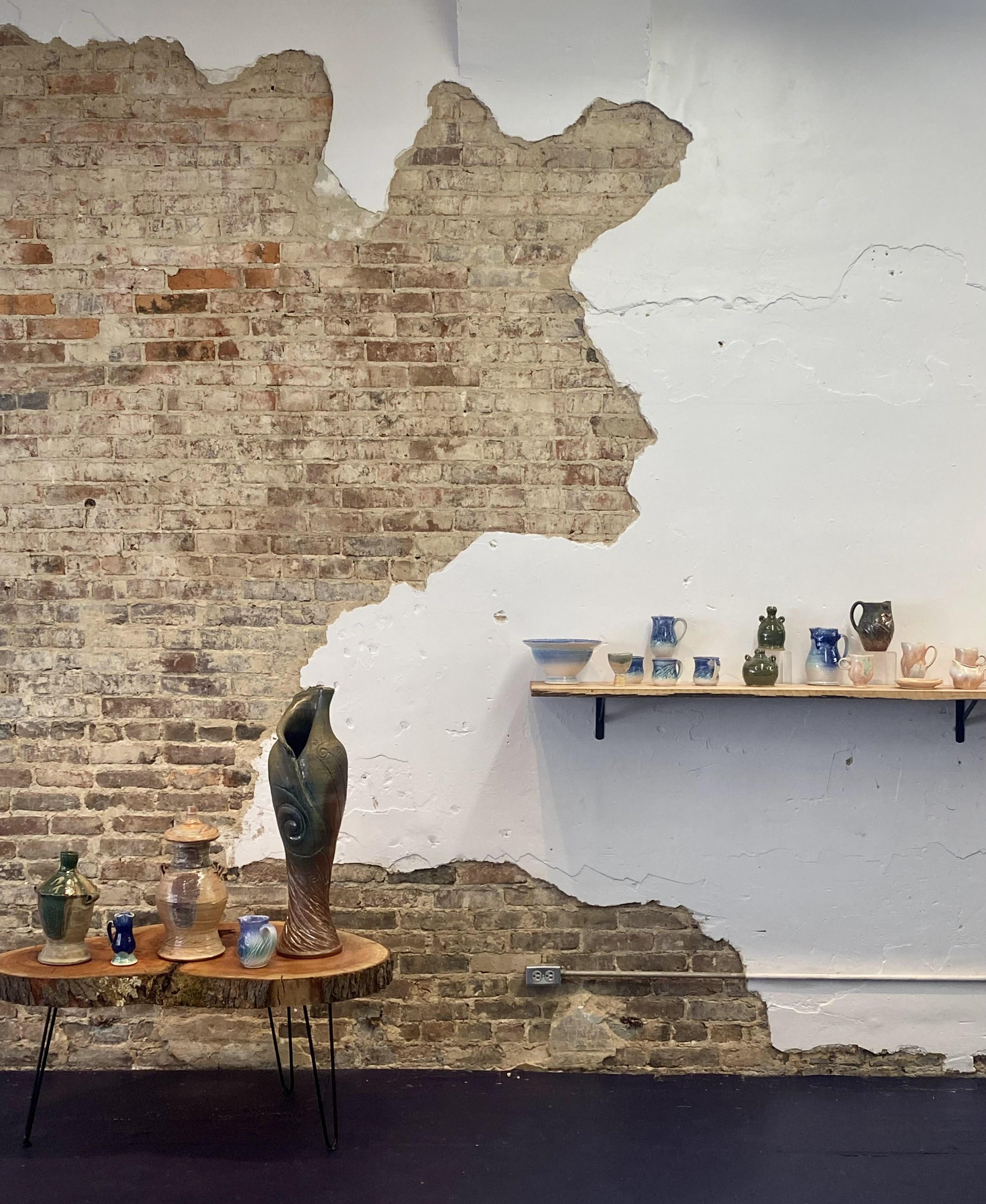
Start Your Engines! A Celebration of Racing in Montgomery County is open now at the Customs House Museum & Cultural Center. The exhibit is sponsored by Tri-Star Beverage and MPG Transport and spans across several galleries within the Museum.
Recognizing the history of auto racing in Montgomery County, Start Your Engines spotlights the local legends that formed the sport in our area, including Jeff Purvis, Tony Albright, Eddie Pace, the Greenfield family and numerous other veterans of dirt track and dragstrip racing. Many racing vehicles will rotate throughout the Museum for the duration of the exhibit; the famed No. 9 NASCAR stock car driven by Kasey Kahne, Barry Carpenter’s epic 1968 drag rail, Mickey Jerles’ prized crate late model and more.
“This exhibition has morphed and grown over time since its inception – like our city,” said Terri Jordan, Curator of Exhibits. “We are thrilled to bring an exhibition to the public featuring an iconic and historic location in Clarksville – the Clarksville Speedway and Fairgrounds – and the stories, artifacts and memories of its family, its patrons, the pit crews and drivers.”
Additionally, a three-part documentary series was produced by Goodwin Productions for CDE Lightband’s Clarksville Community Network, complete with interviews from local drivers, track owners and racing influencers.
Start Your Engines! A Celebration of Racing in Montgomery County is on view at the Customs House Museum & Cultural Center through December 31. Discover more stories from the Clarksville Speedway in the Start Your Engines commemorative magazine, available for purchase at Seasons: The Museum Store.
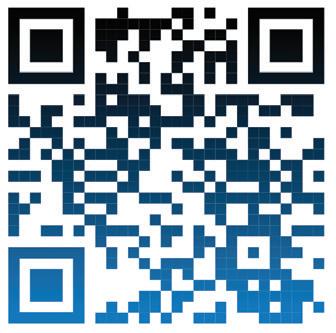
Pottery Studio & Fine Art Gallery Bringing the art of handmade pottery to Downtown Clarksville. 115 Franklin St. Clarksville, TN 37040 931-542-6615 Rivercityclay@gmail.com @rivercityclay Visit Rivercityclay.com to book a pottery class today! Hours of Operation: Monday - Tuesday: Closed Wed. - Friday: 12PM - 8PM Saturday: 10AM - 9PM Sunday: 11AM - 5PM Clarksville, TN (931) 647-1501 | Springfield, TN (615) 382-4420 BATSONNOLAN.COM Clarksville, TN (931) 647-1501 | Springfield, TN (615)
BATSONNOLAN.COM Clarksville, TN (931) 647-1501 | Springfield, TN (615) 382-4420 BATSONNOLAN.COM
382-4420

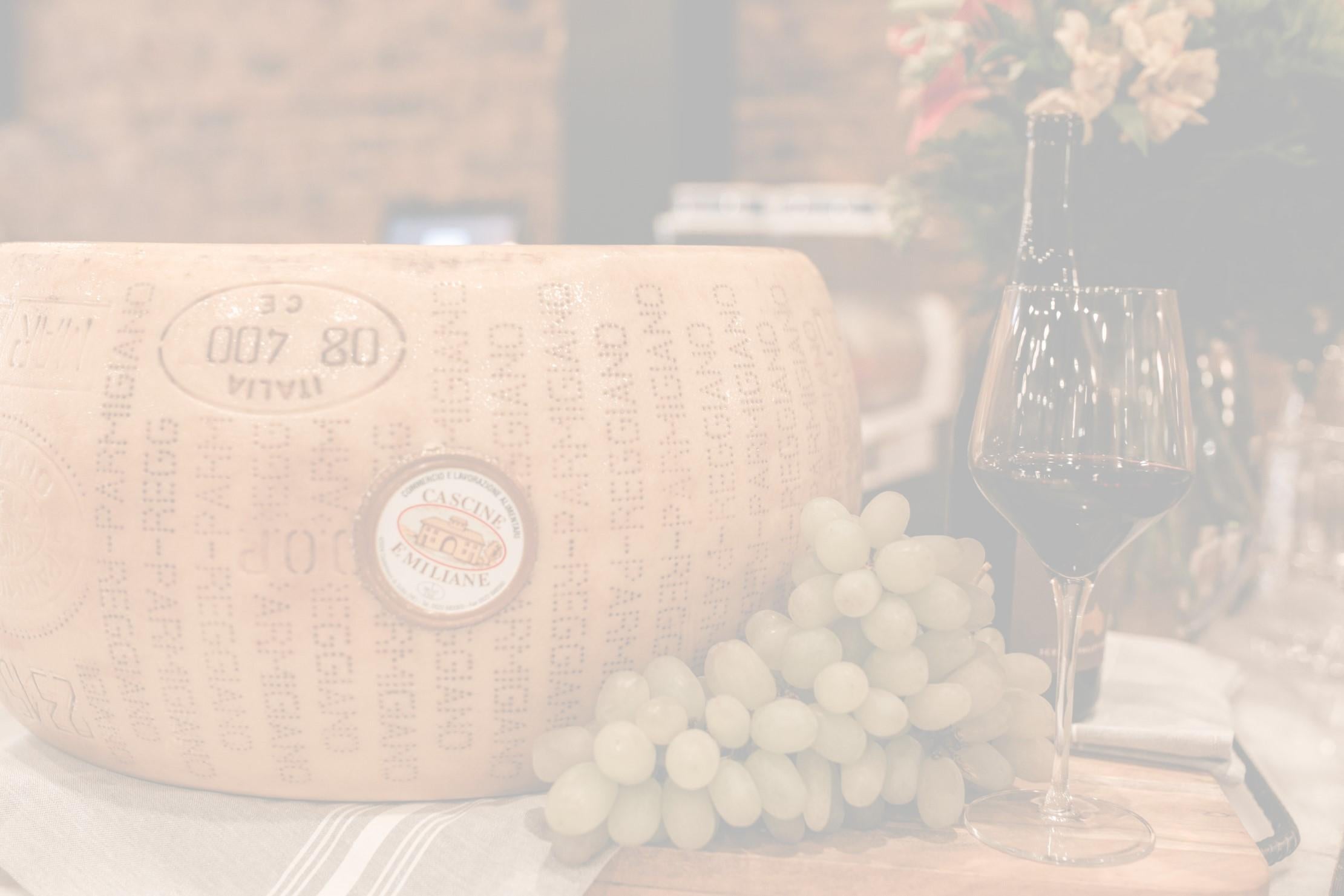




24 / SECOND & COMMERCE THE ONLY CICCHETTI BAR IN TN CRAFT COCKTAIL BAR FULL SERVICE COFFEE BAR CLARKSVILLE’S ONLY TRUE WOOD FIRED PIZZA OVEN LUNCH DINNER Historic Downtown Clarksville 111 Franklin Street
CRAFTED IN CLARKSVILLE









Treat yourself or find the perfect gift at Seasons: The Museum Store! You’ll find everything from Museum-branded merchandise to beautifully crafted jewelry, pottery and woodwork from local artisans.
An Inconvenient Acquaintance, $15 By Sara Turnquist, Historical Romance Author saraturnquist.com
pin, $60 Ornament, $15
Jack Bastin, Woodworker
$40
art coasters, $10 ea.
Alexis Leverette, Anonymous Exposures instagram.com/anonymous___exposures
baby rattle, $16.50
Beaded necklace, $25 Beaded bracelet, $30 by Hilda Walker, Creative Musings by Hilda hildasmusings.etsy.com
Rolling
by
Vase,
by Brigitta Dixon, Flaming Mud Productions flamingmud.biz Fluid
by
Crocheted
by Lisa Adames, Knockout Originals facebook.com/littlefuzzyduck @seasonsmuseumstore
RENOVATED EXPLORERS LANDING AIMS TO EDUCATE AND INSPIRE



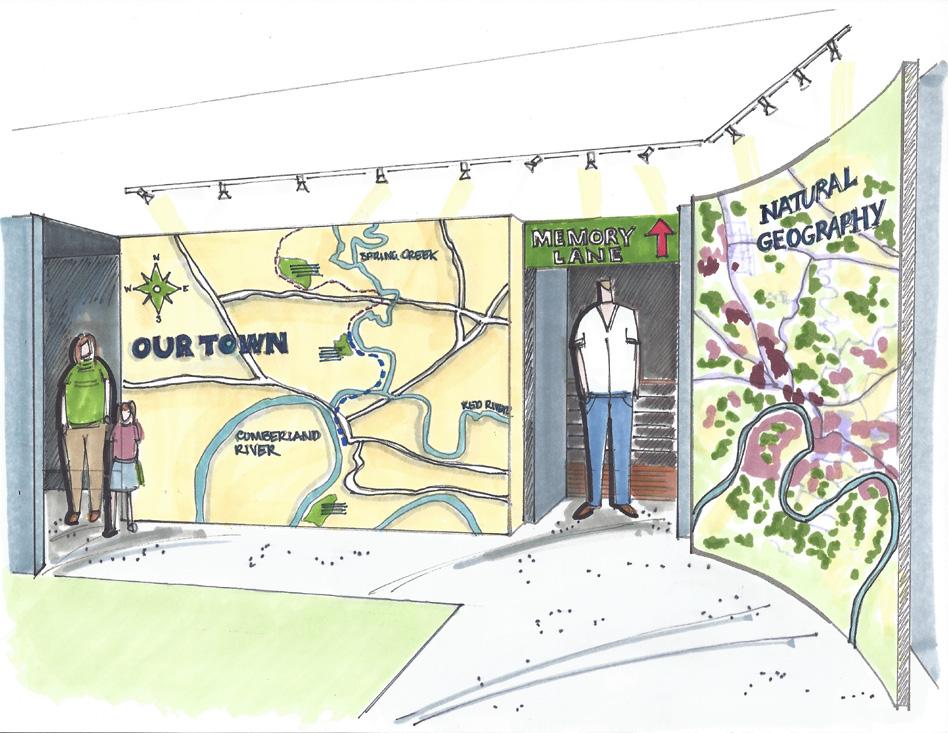
The Museum will ring in 2022 with a major remodel of Explorers Landing, the popular children’s area housed in the original 1898 Customs House building. This new and improved hands-on educational space highlights the different elements that make up a town like Clarksville, from farming and transportation to local wildlife and the Cumberland River. The renovation includes new interactive activities and learning opportunities, while revamping favorites like the Bubble Cave and McGregor’s Market.
The Explorers Landing Renovation has been made possible by:
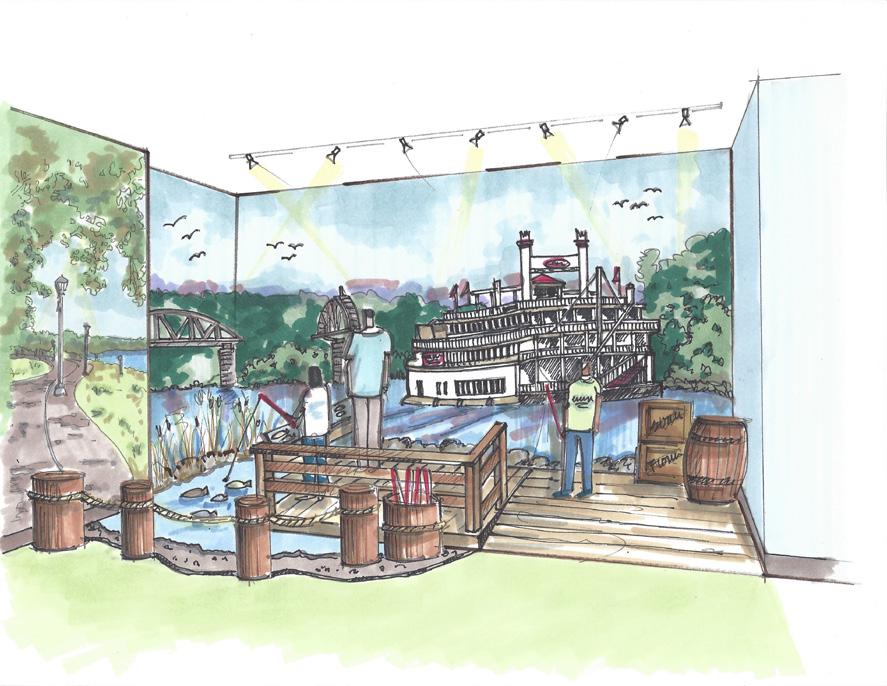

Kiwanis Club Of Clarksville
Clarksville-Montgomery County Community Health Foundation F&M Bank
Providence Builders

Clarksville Gas & Water
CDE Lightband
26 / SECOND & COMMERCE



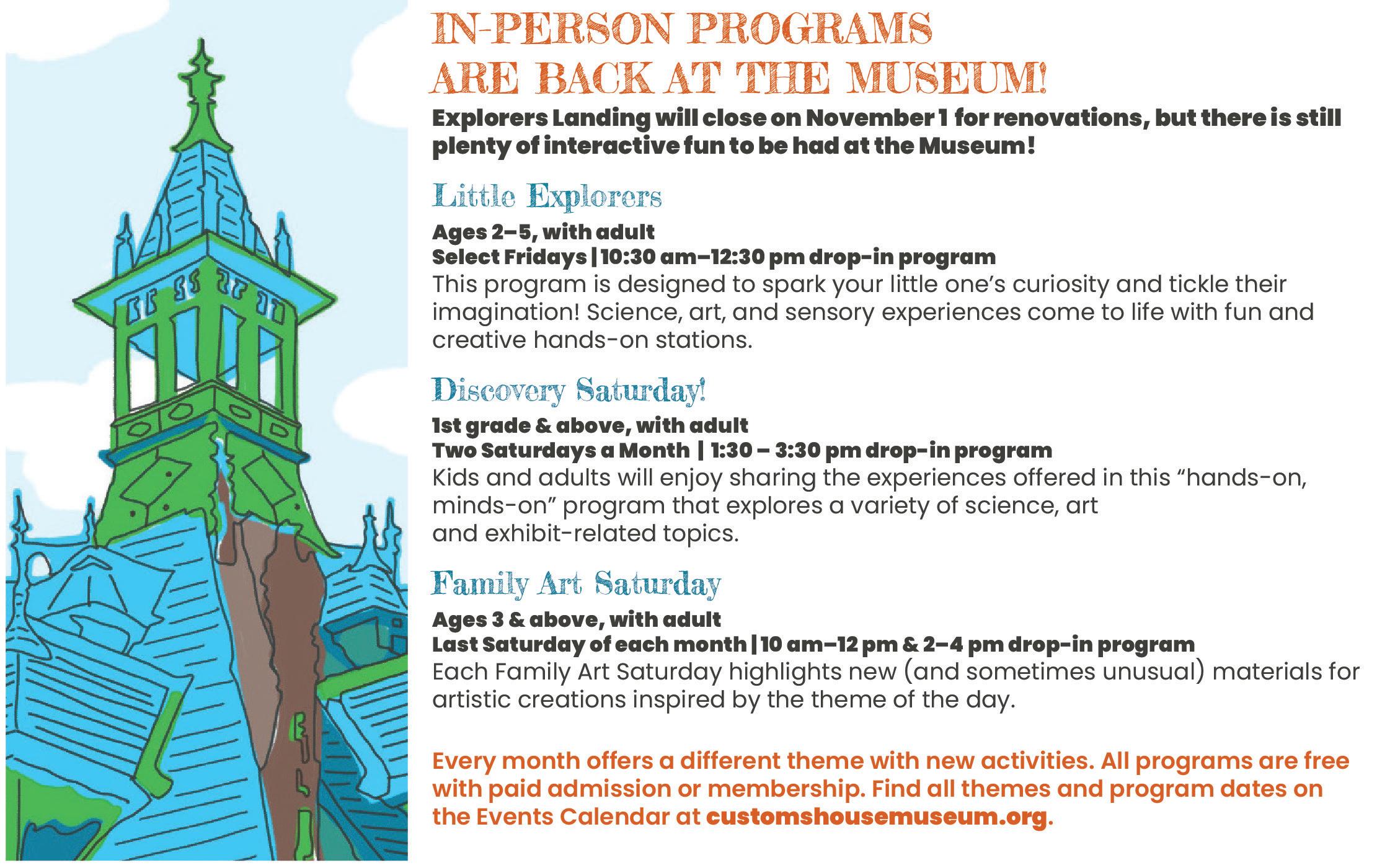
SECOND & COMMERCE / 27 Uncommon Aesthetics & Exceptional Furnishings 120 Franklin St. 131FranklinSt. Ste. 109 @theclarksvillecollection @journeyseyestudio C M Y CM MY CY CMY K


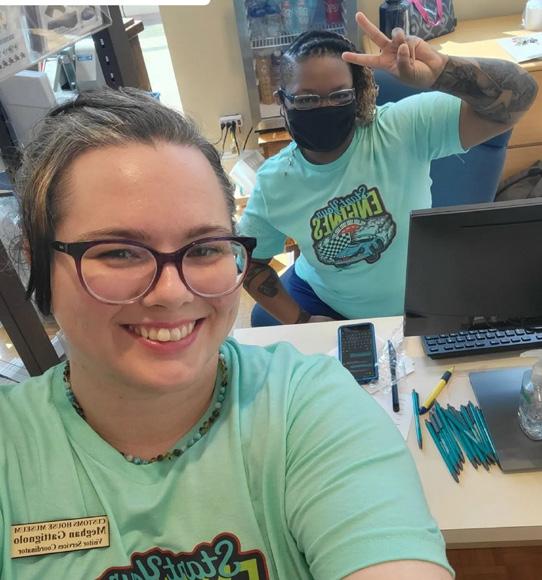

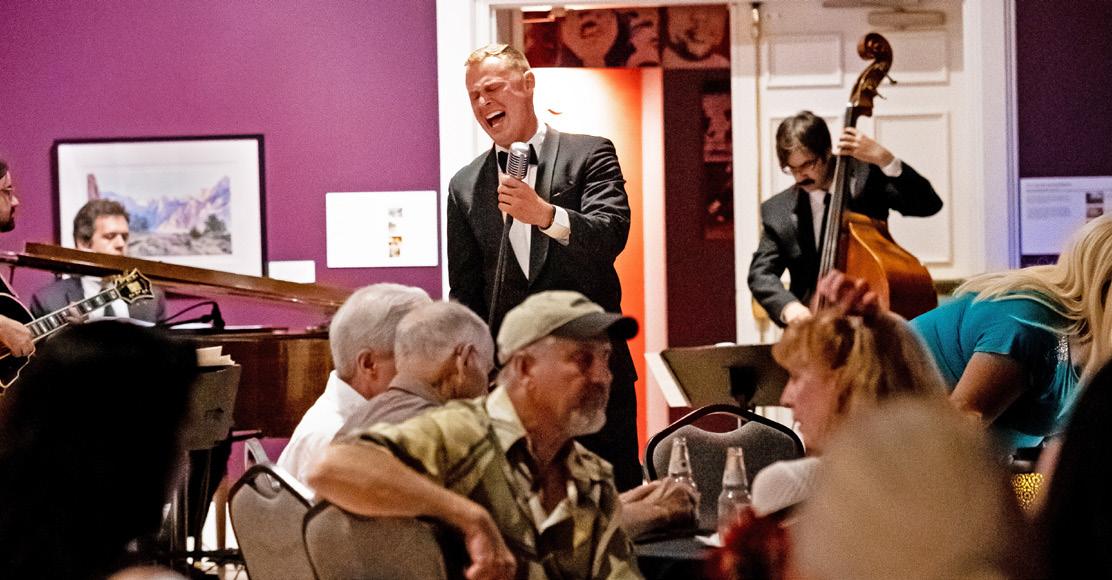
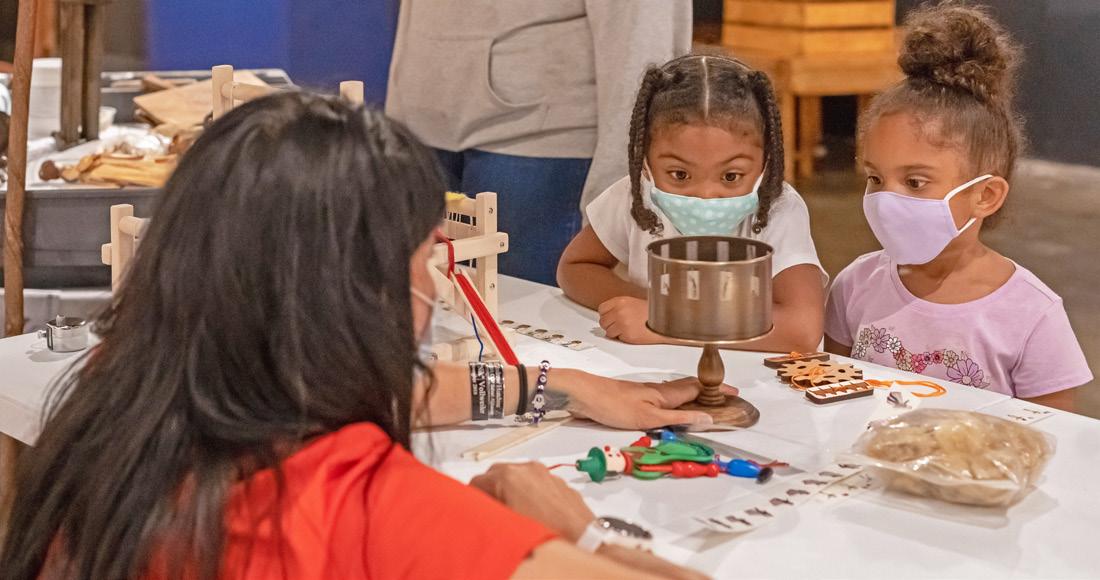
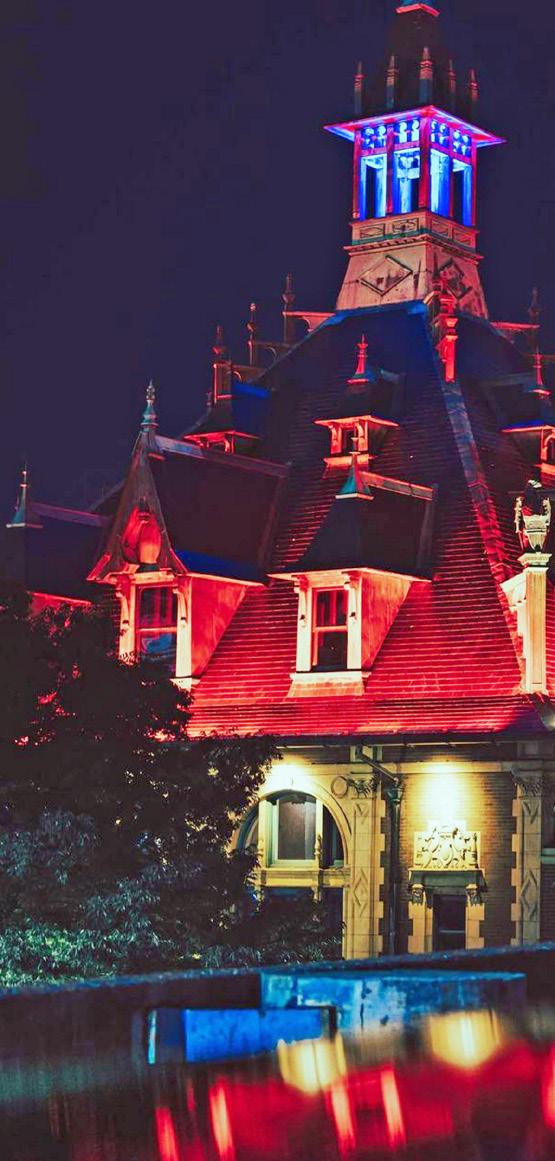



28 / SECOND & COMMERCE There’s always something going on at the Customs House Museum. Share your visit with us! Tag us for a chance to be featured on our social media, in the Museum or right here in Second & Commerce. CONNECT WITH US customshousemuseum.org @customshousemuseum #customshousemuseum @thesleeplessinsomniac @rap_daddy_x2 @rache1peterson @tenjen20 @meggiebeth84 @britneytaylor





Discover Art, History and Science in Downtown Clarksville! Become a Museum member today! Members enjoy free Museum admission for a year, invites to exclusive events, store discounts and reciprocal admission to museums across the country. Annual memberships start at $35. Find general admission and special rates at customshousemuseum.org. 200 S. Second Street Downtown Clarksville 931-648-5780 customshousemuseum.org
S H O P
DI N E
FR OL I C
BA NK


myfmbank.com
.
.
.
. DO W N T O W N C LARKSVI L L E Member FDIC NMLS ID 518158 Clarksville Montgomery County Historical Museum d.b.a. P.O. Box 383 Clarksville, TN 37040 customshousemuseum.org NONPROFIT ORG. U.S. POSTAGE PAID CLARKSVILLE, TN PERMIT NO. 530